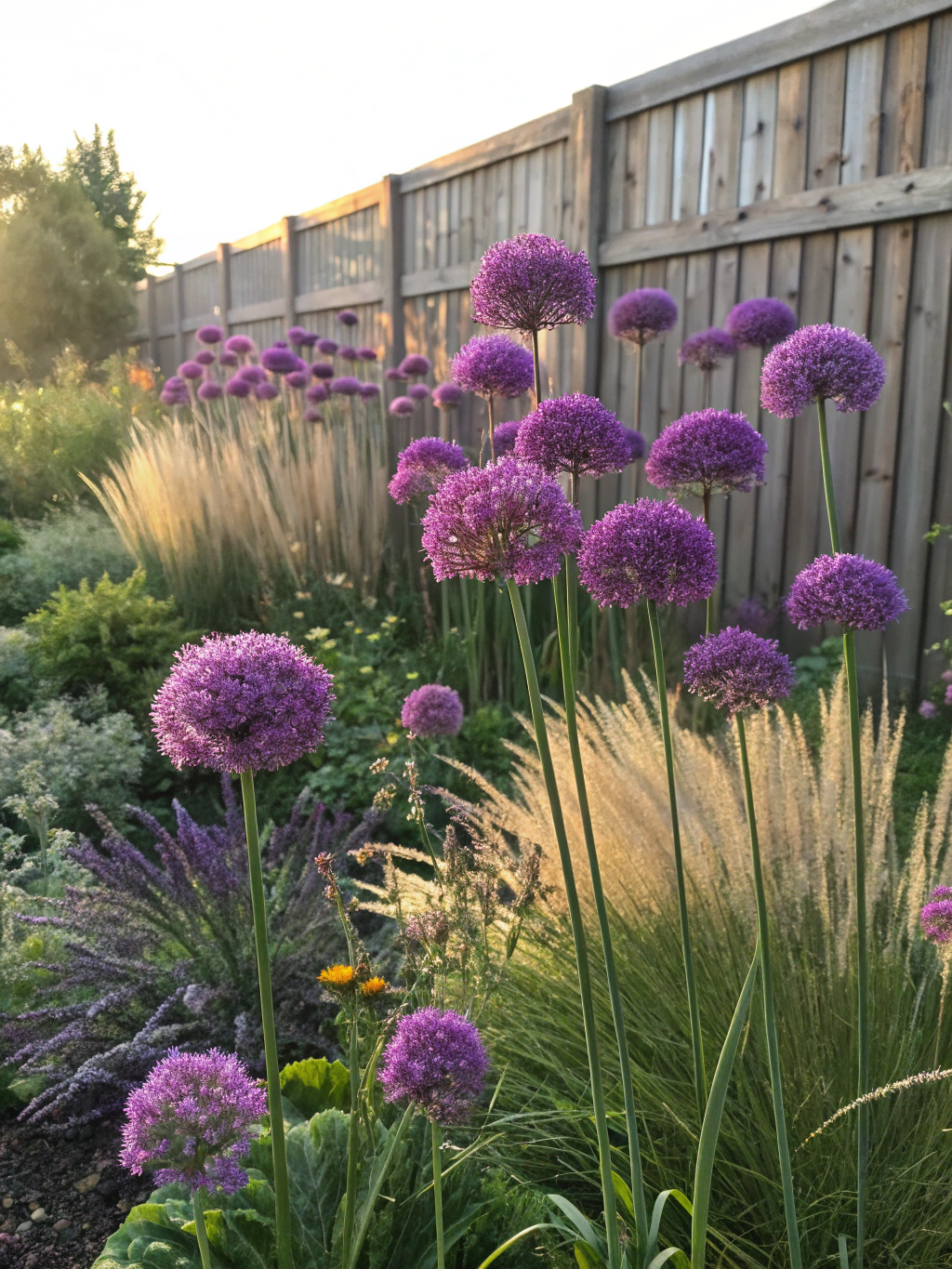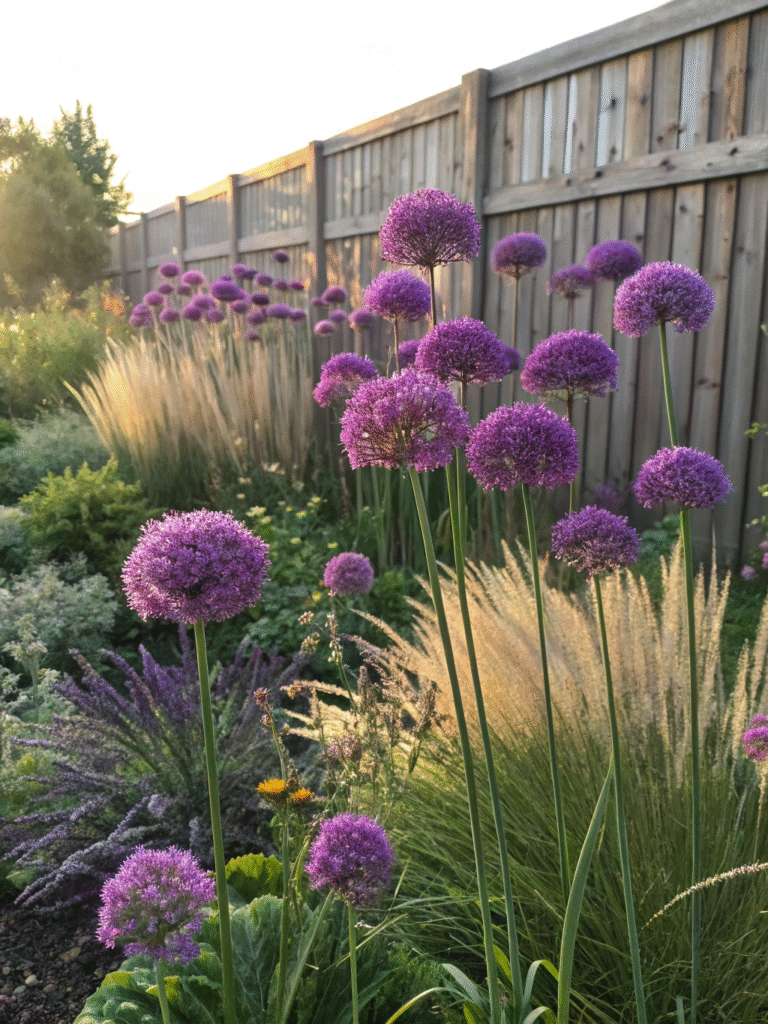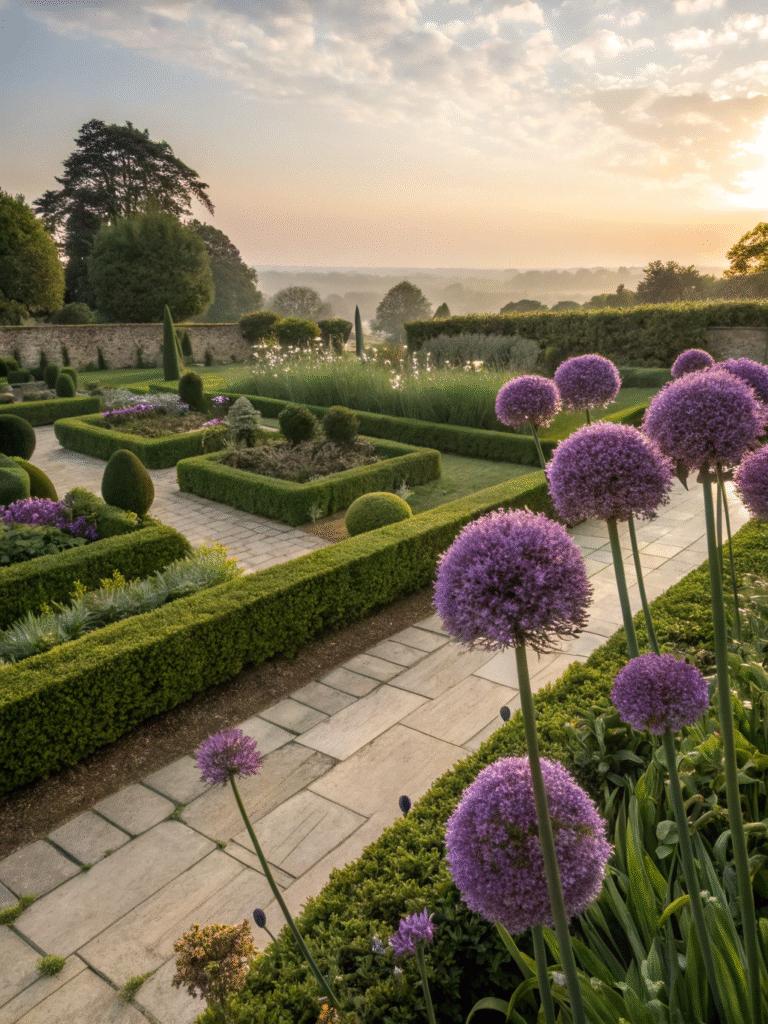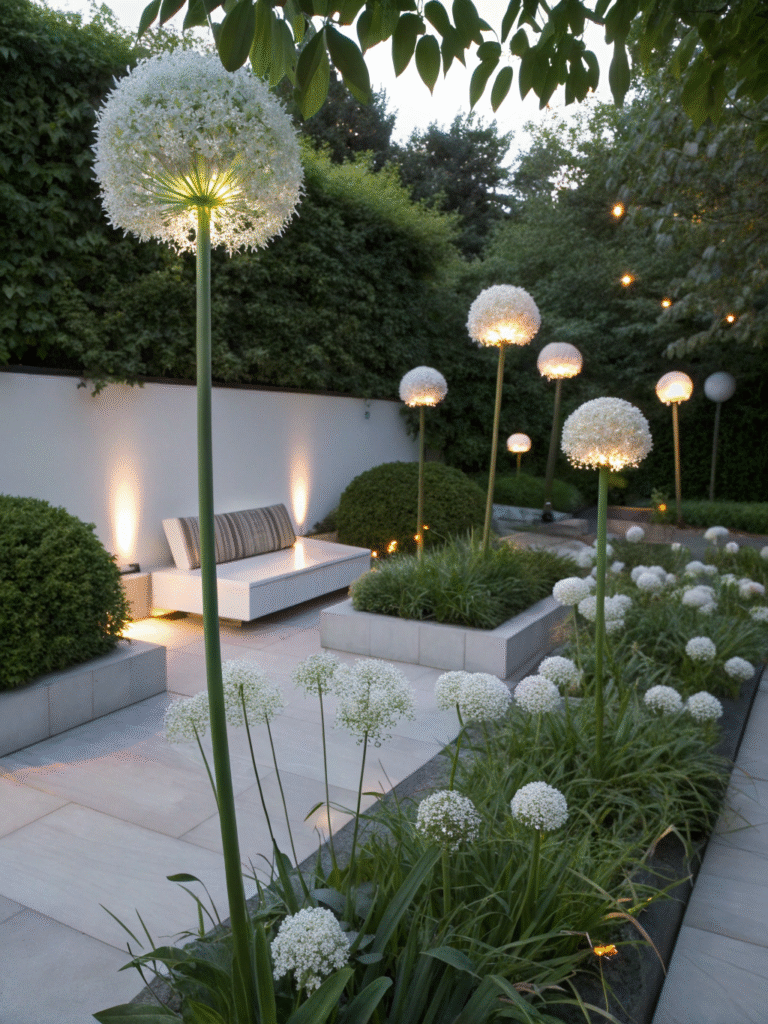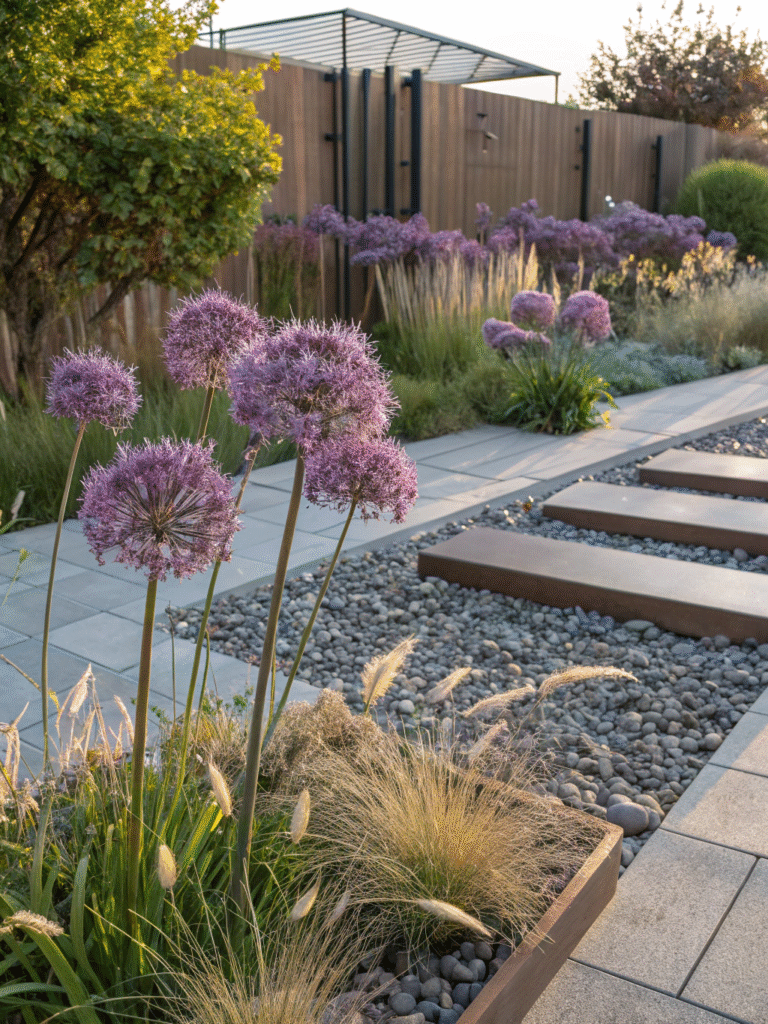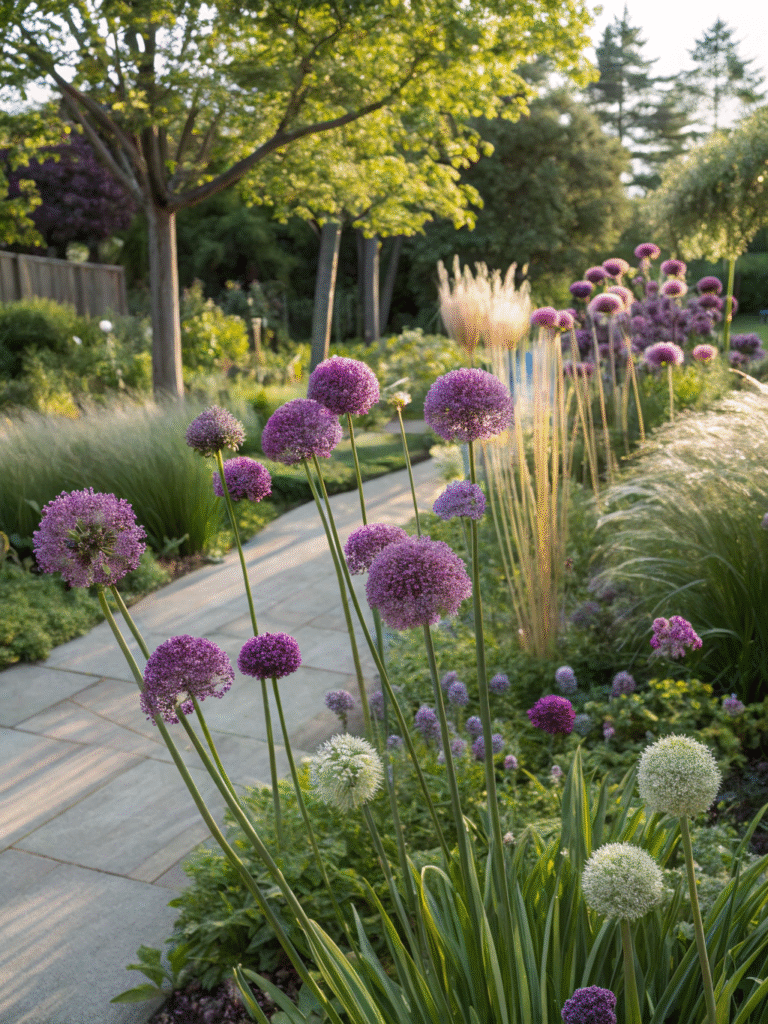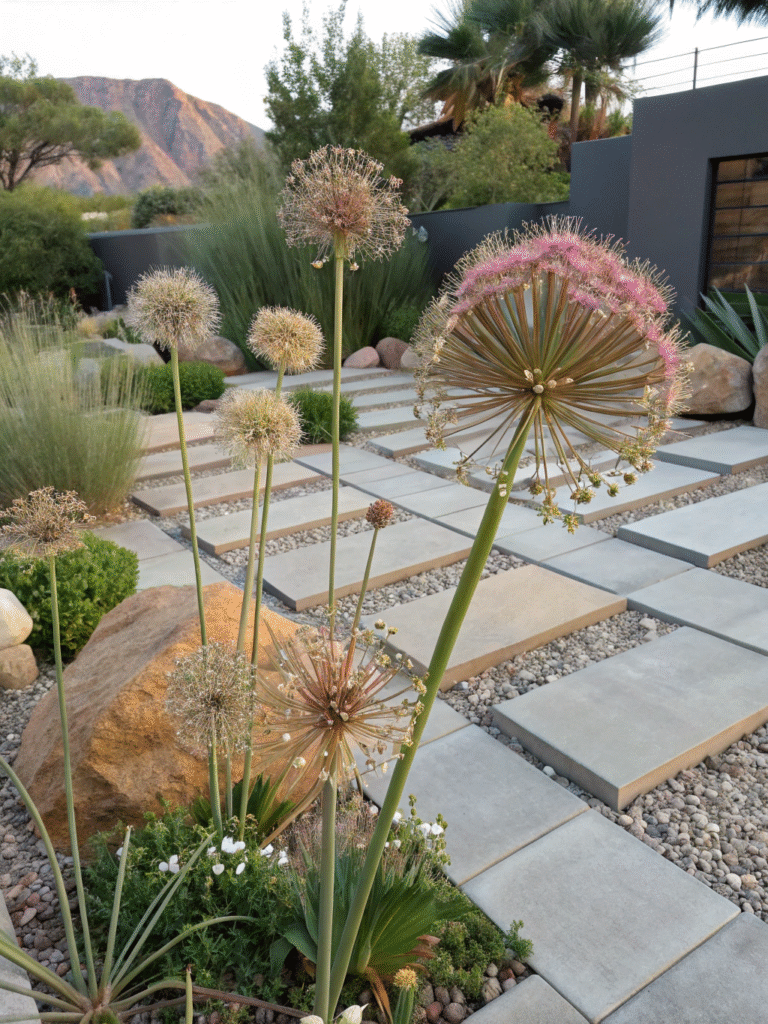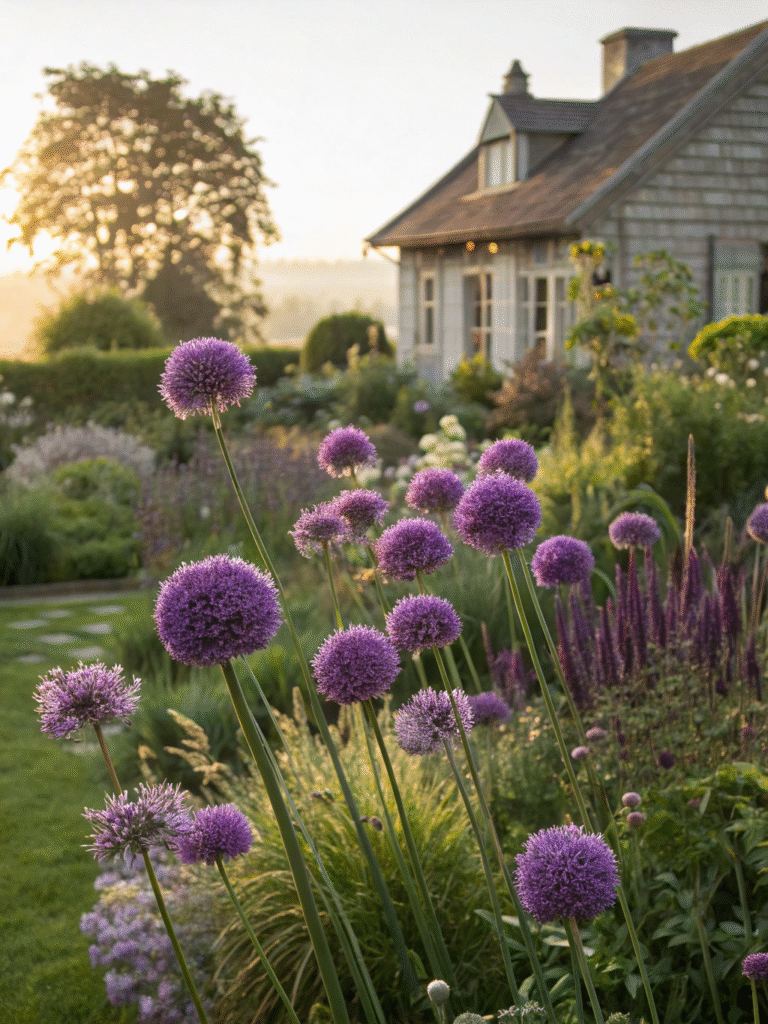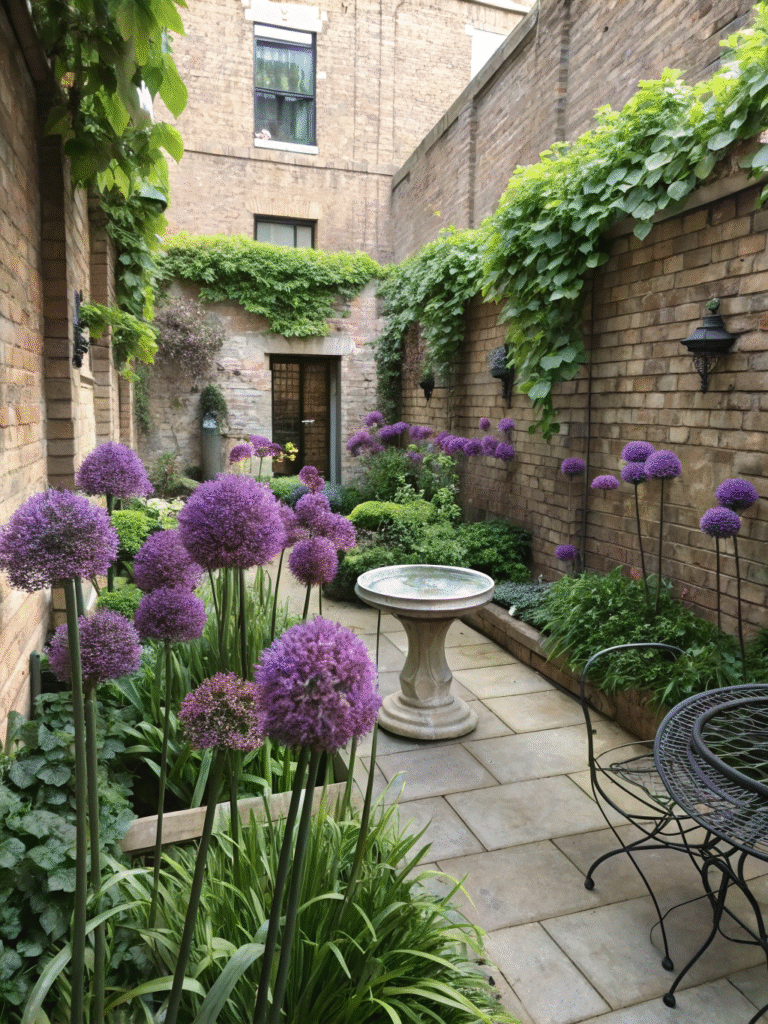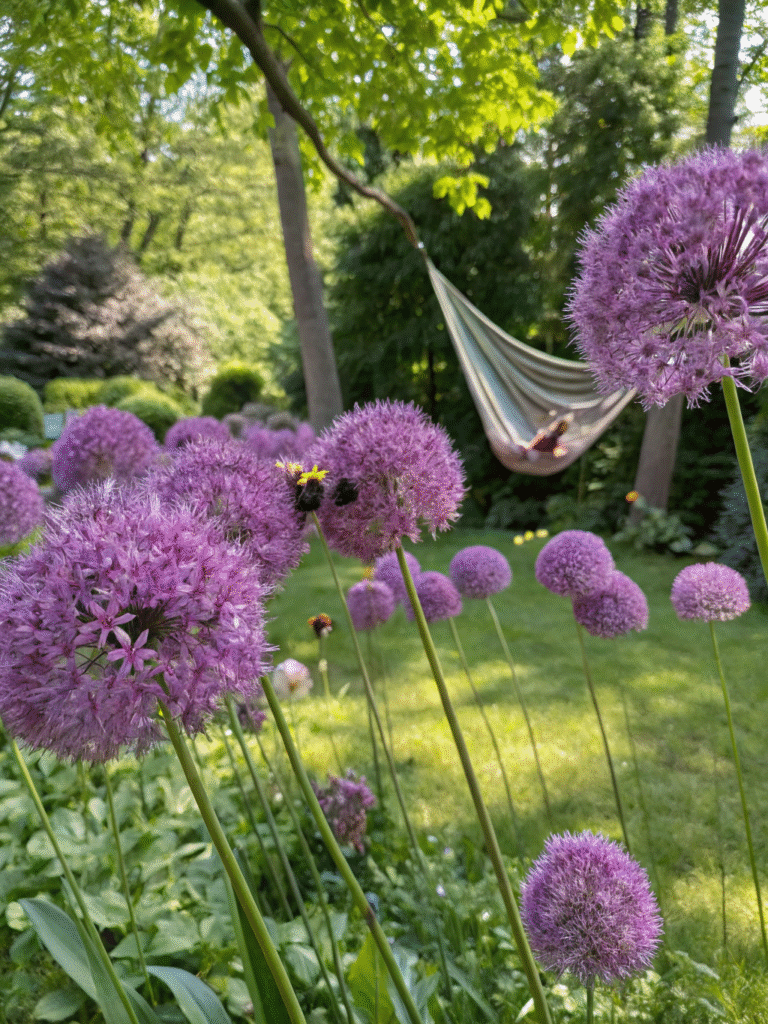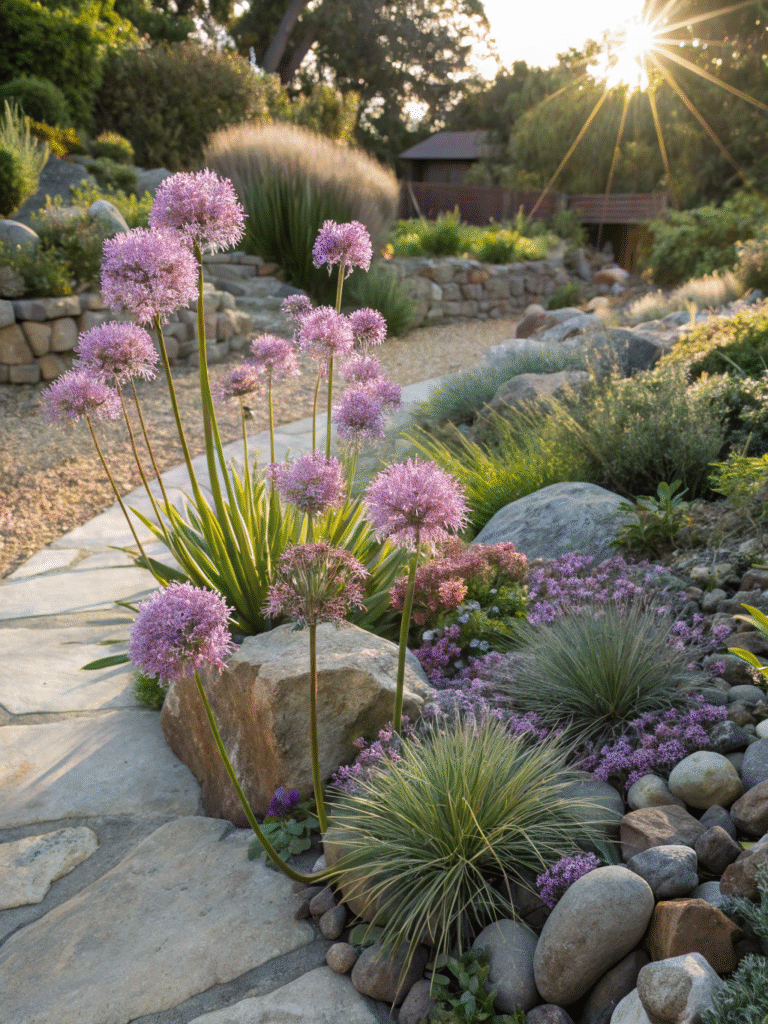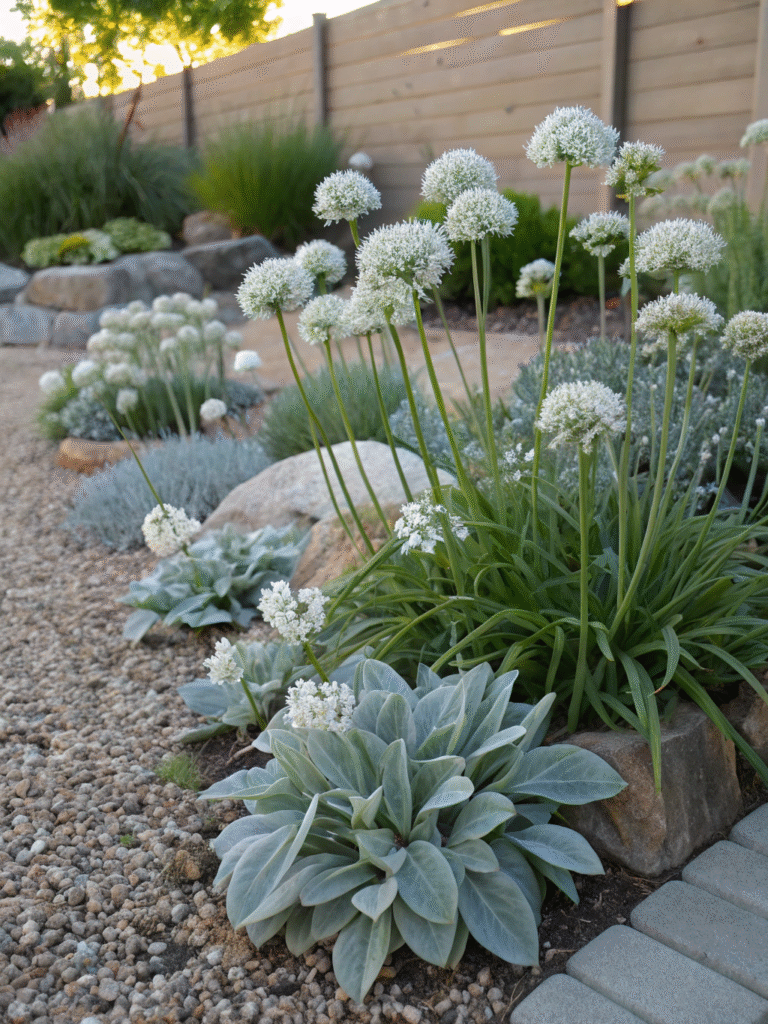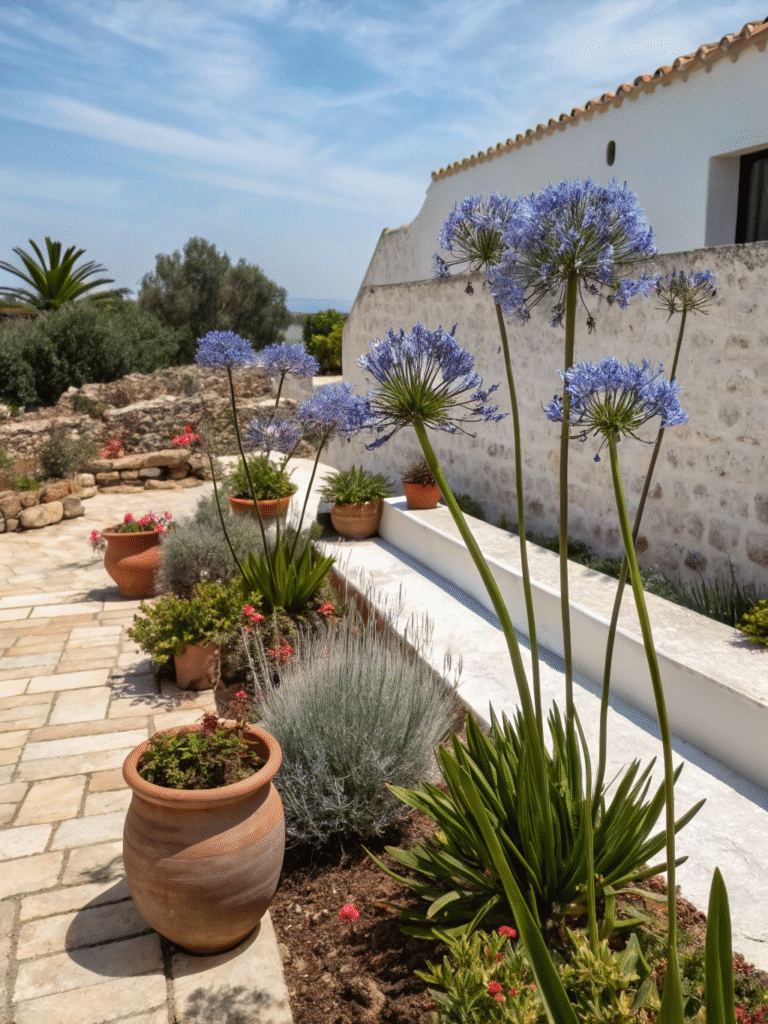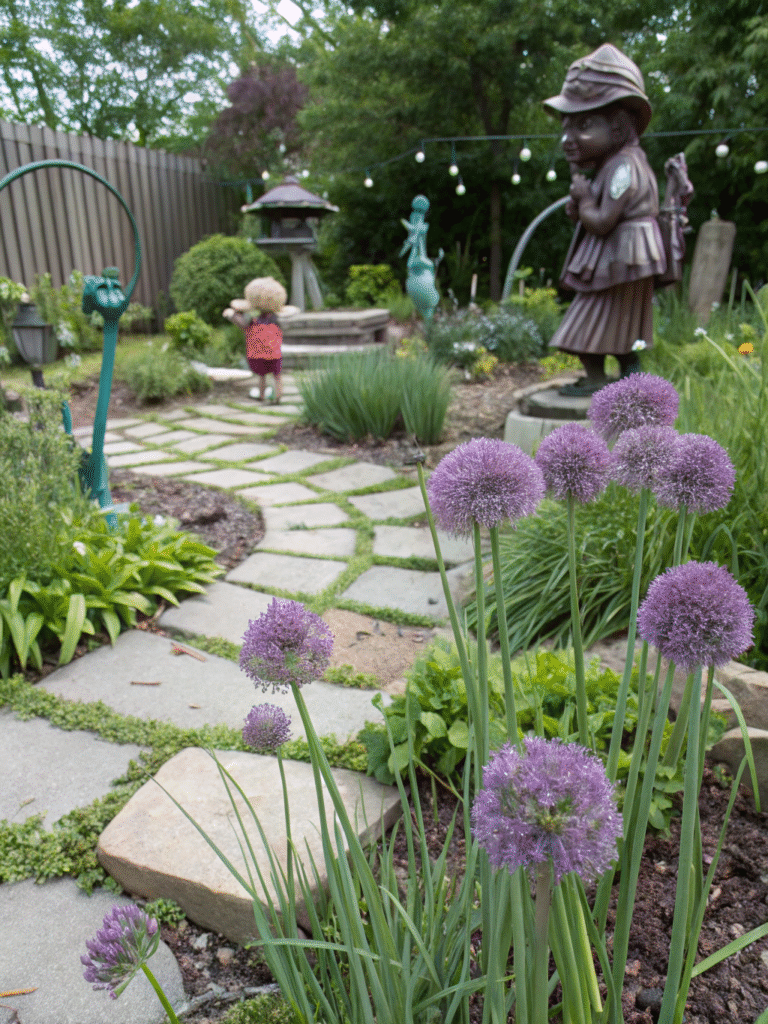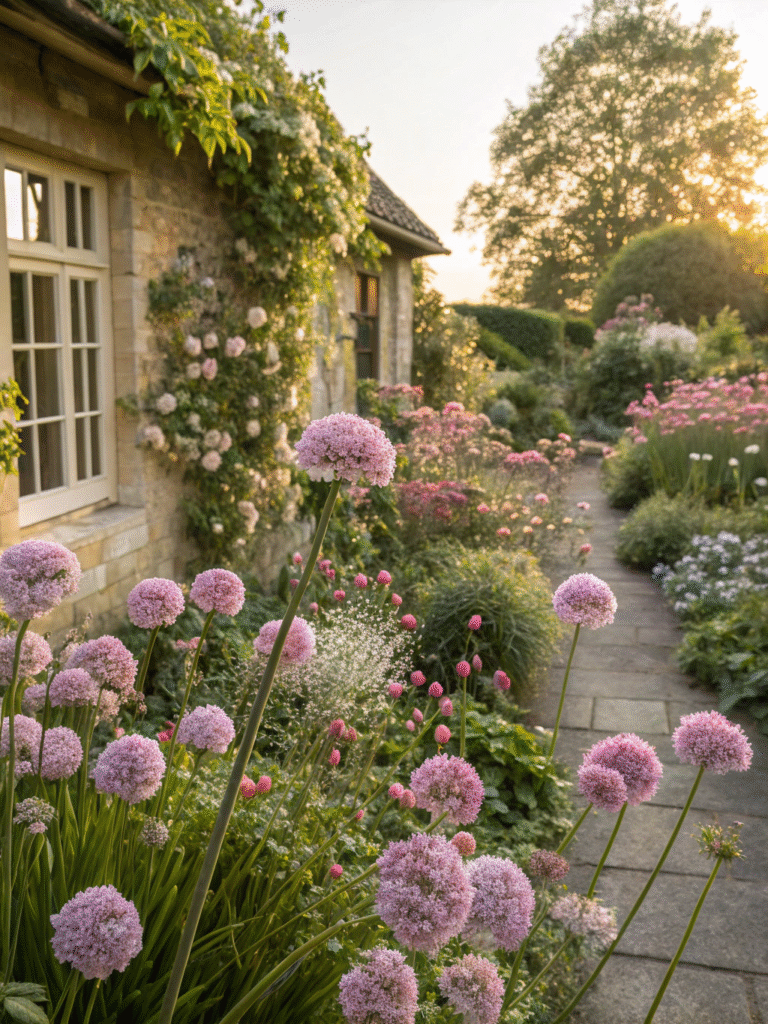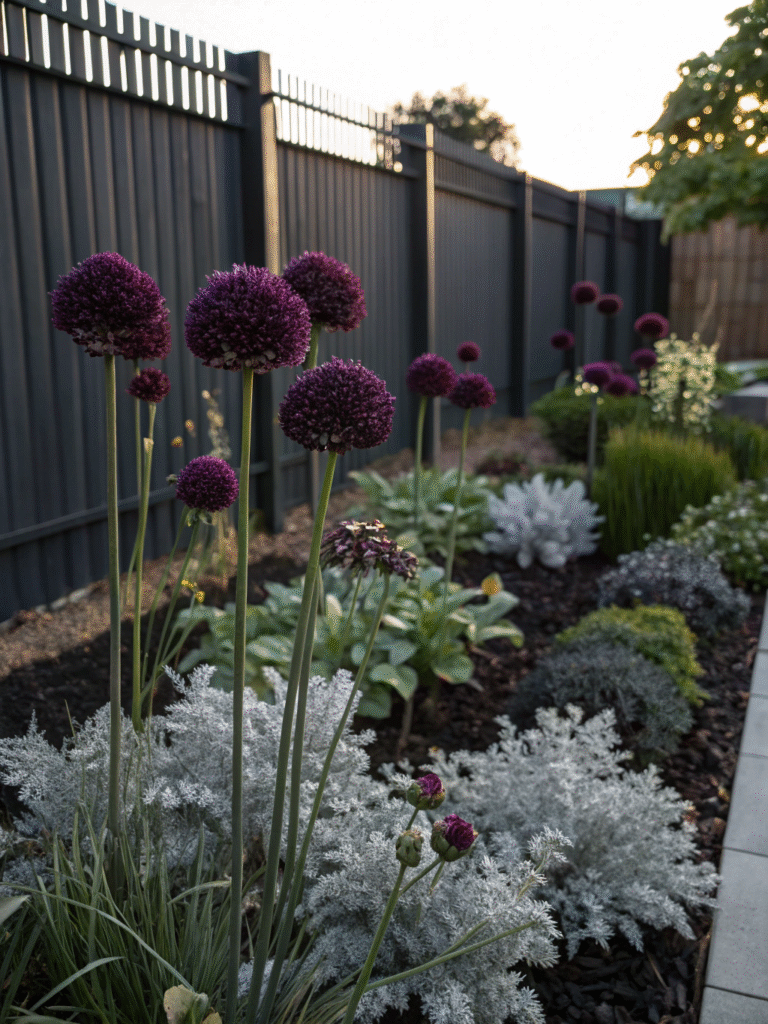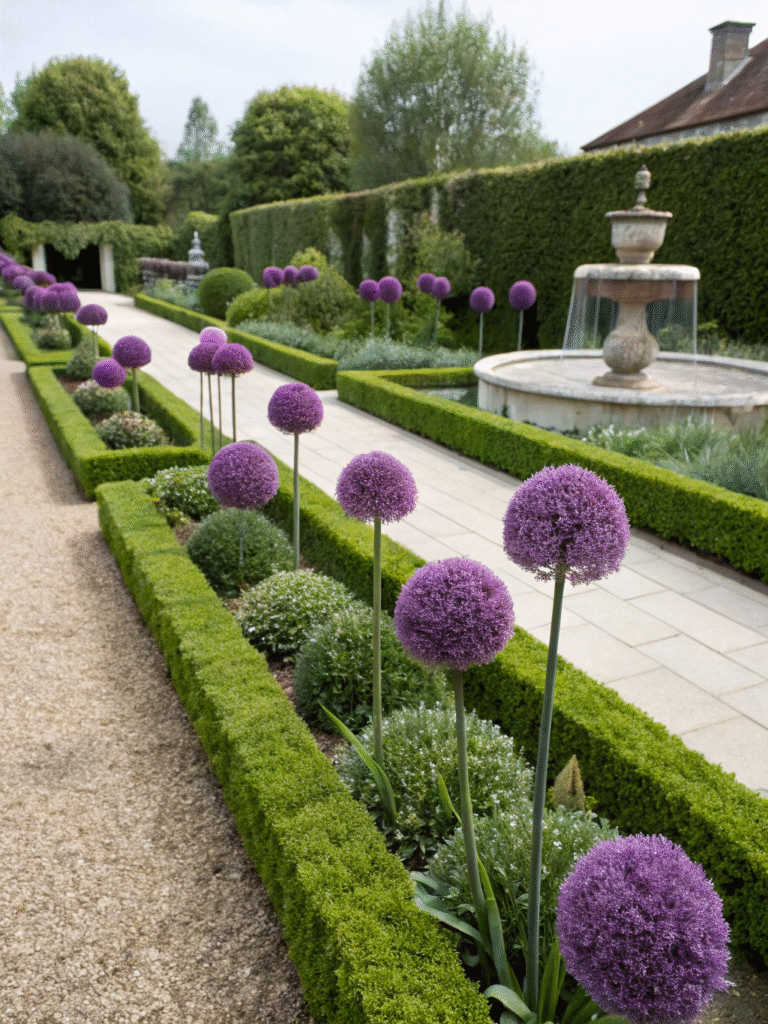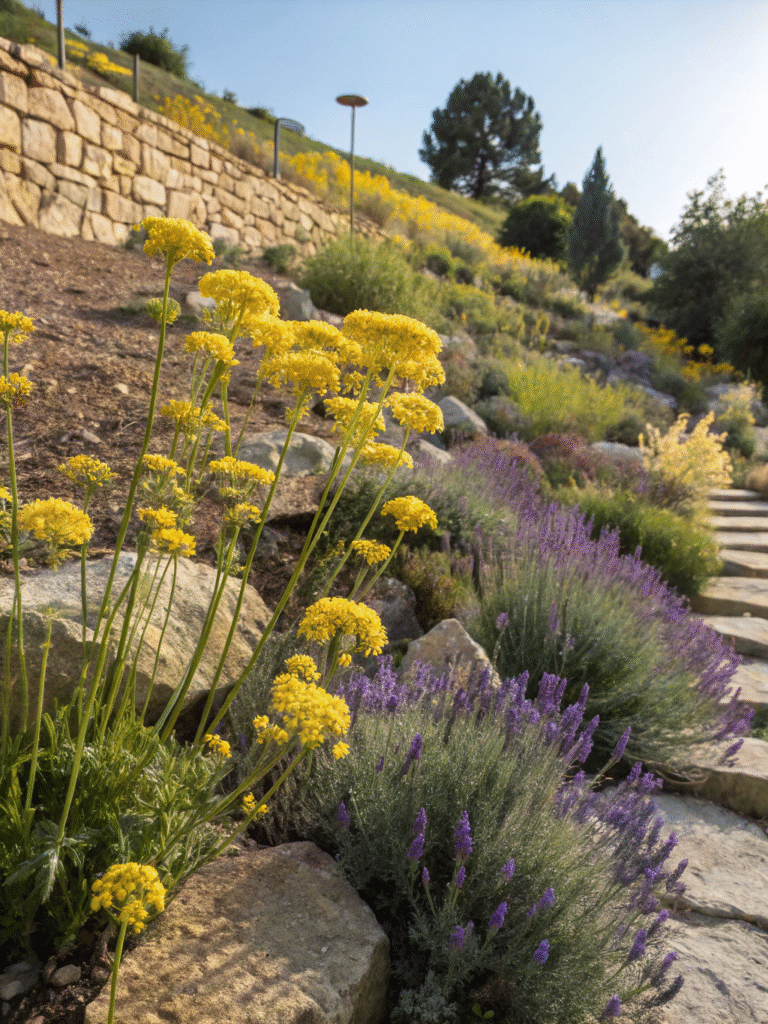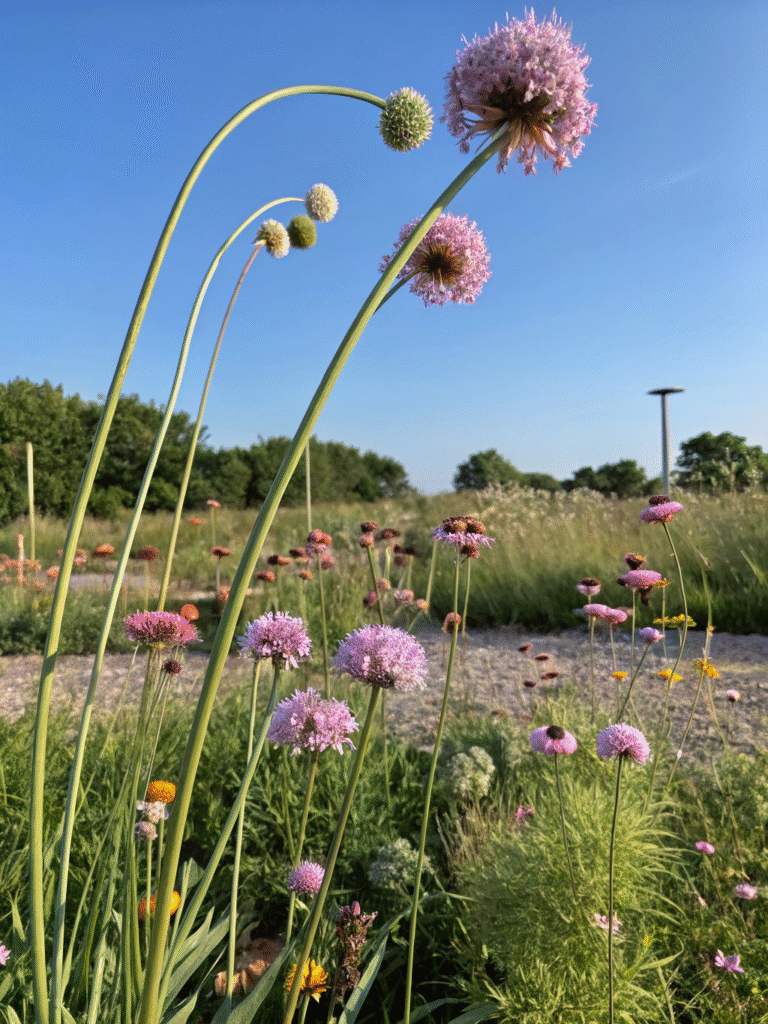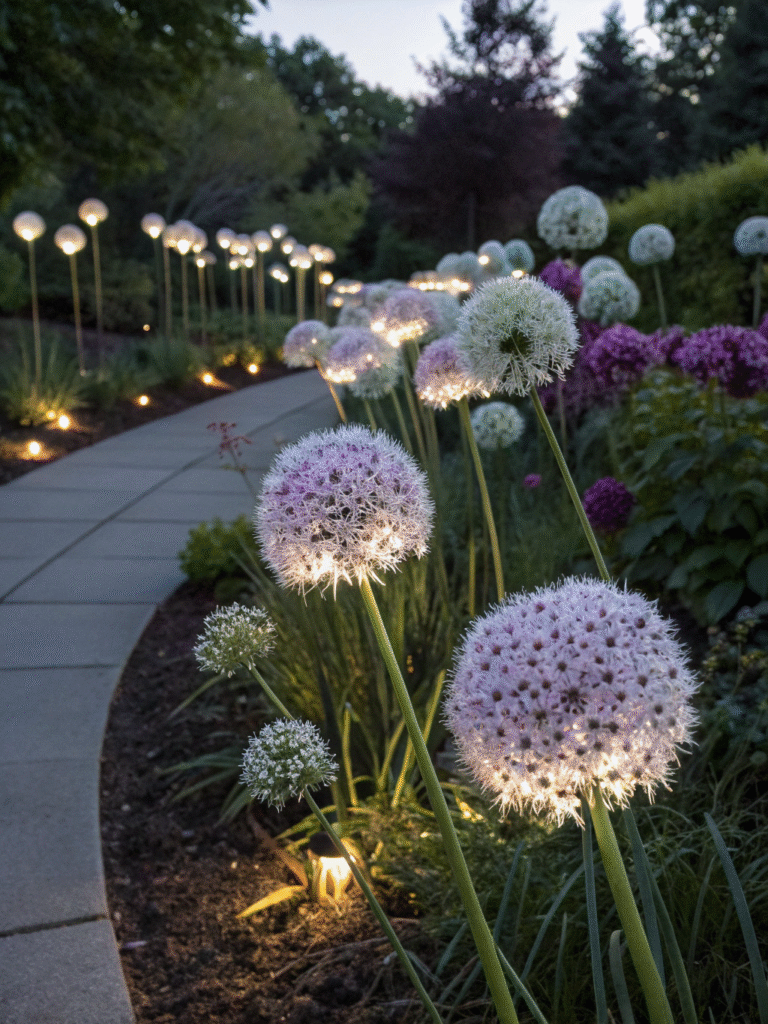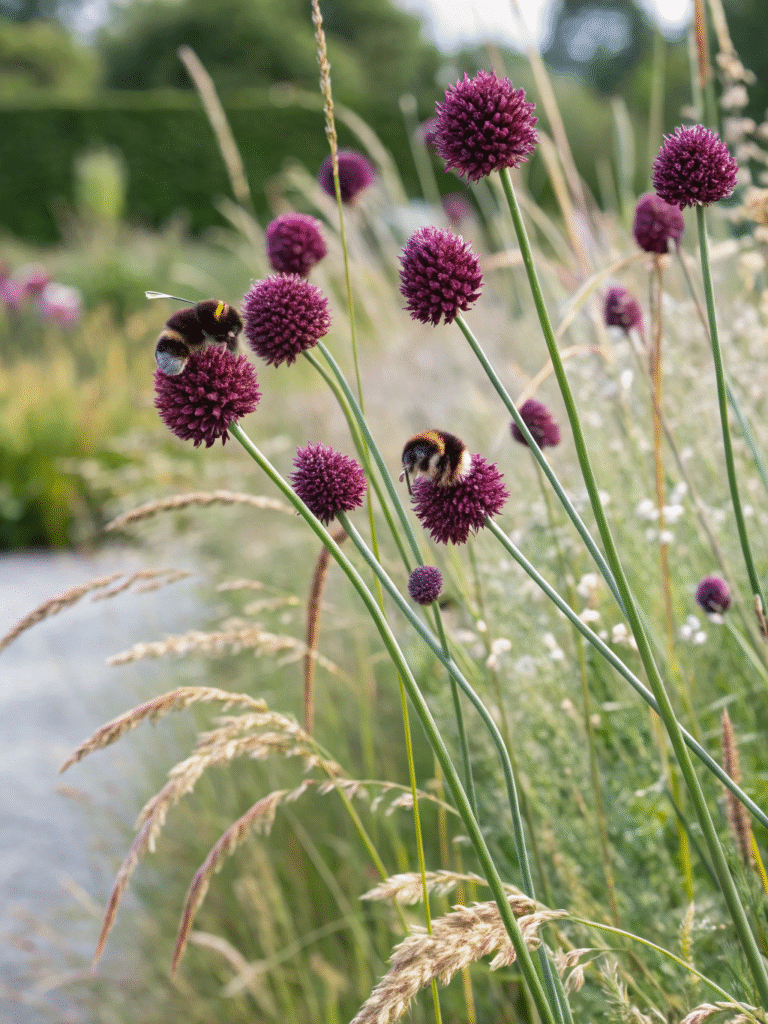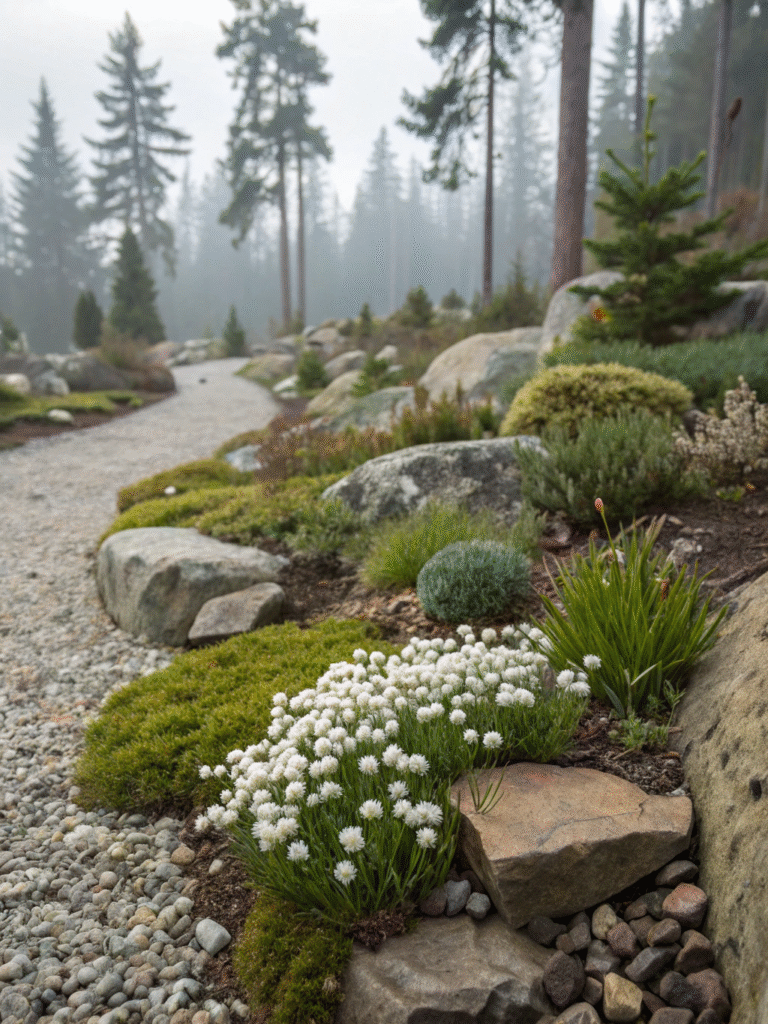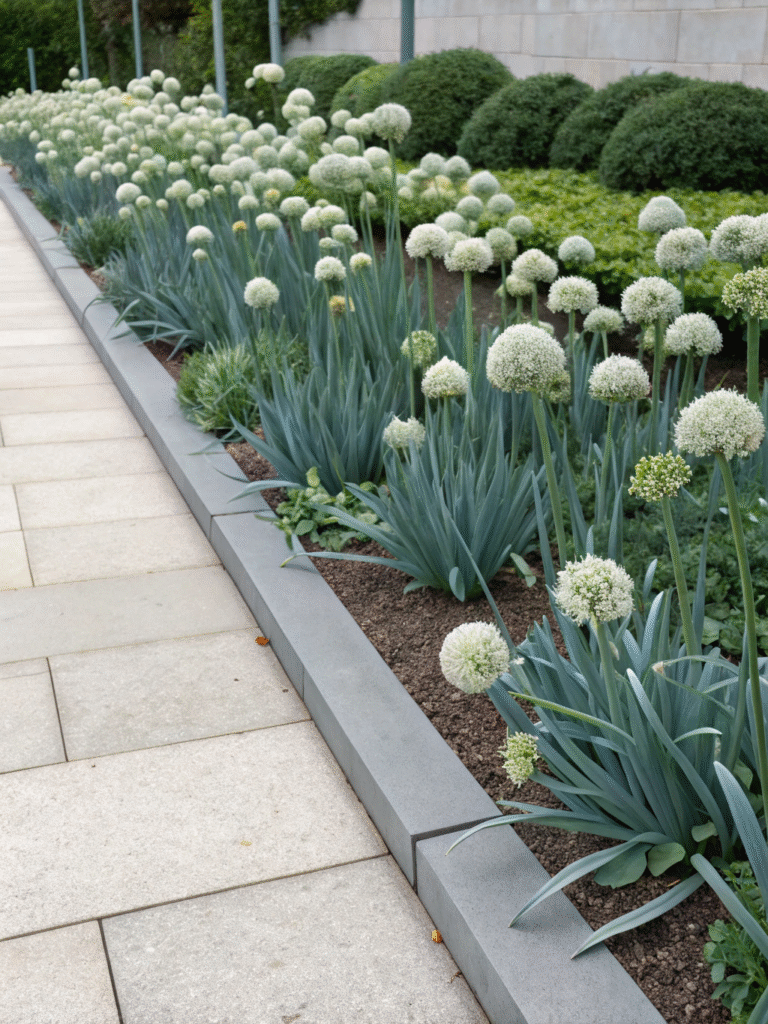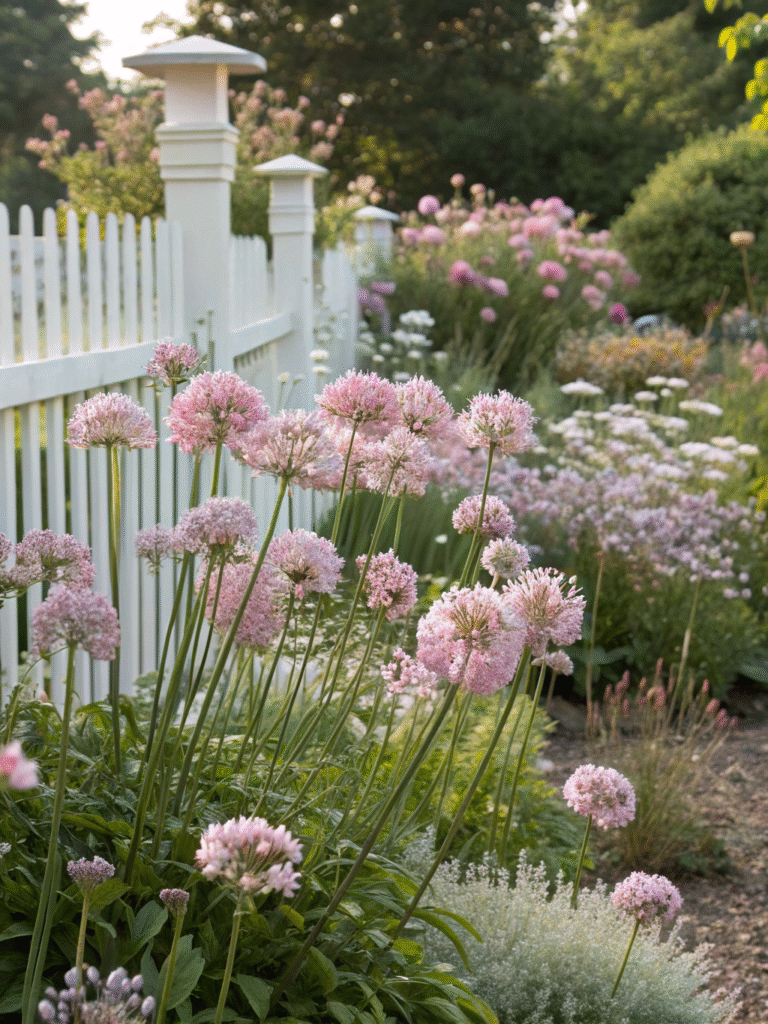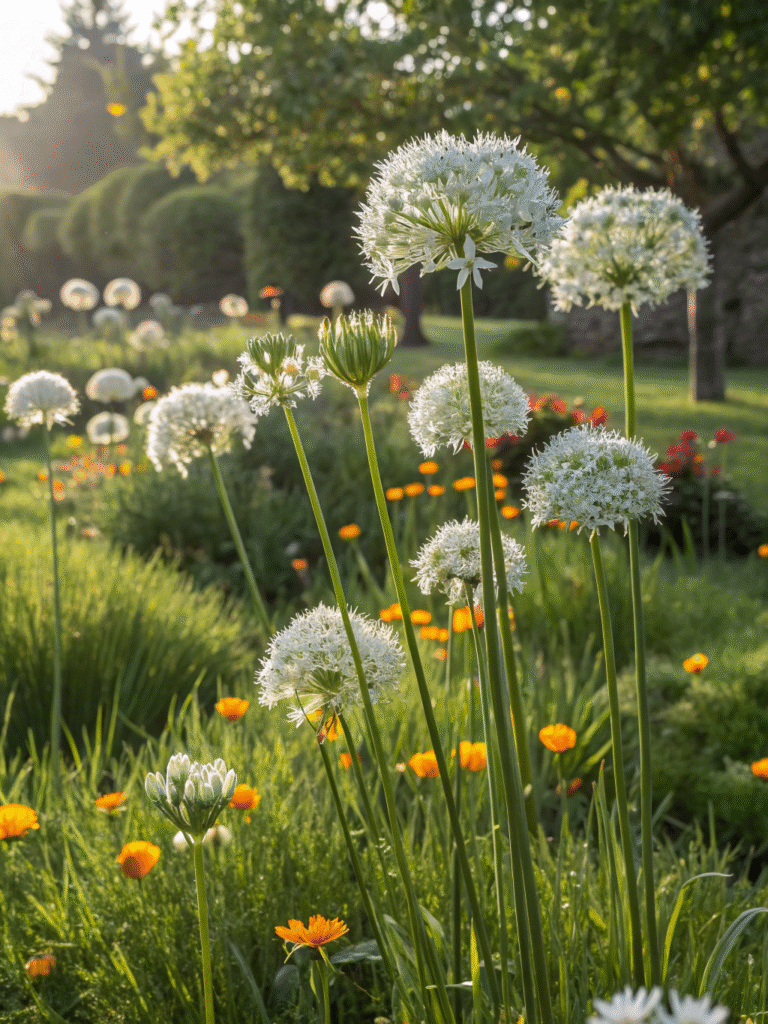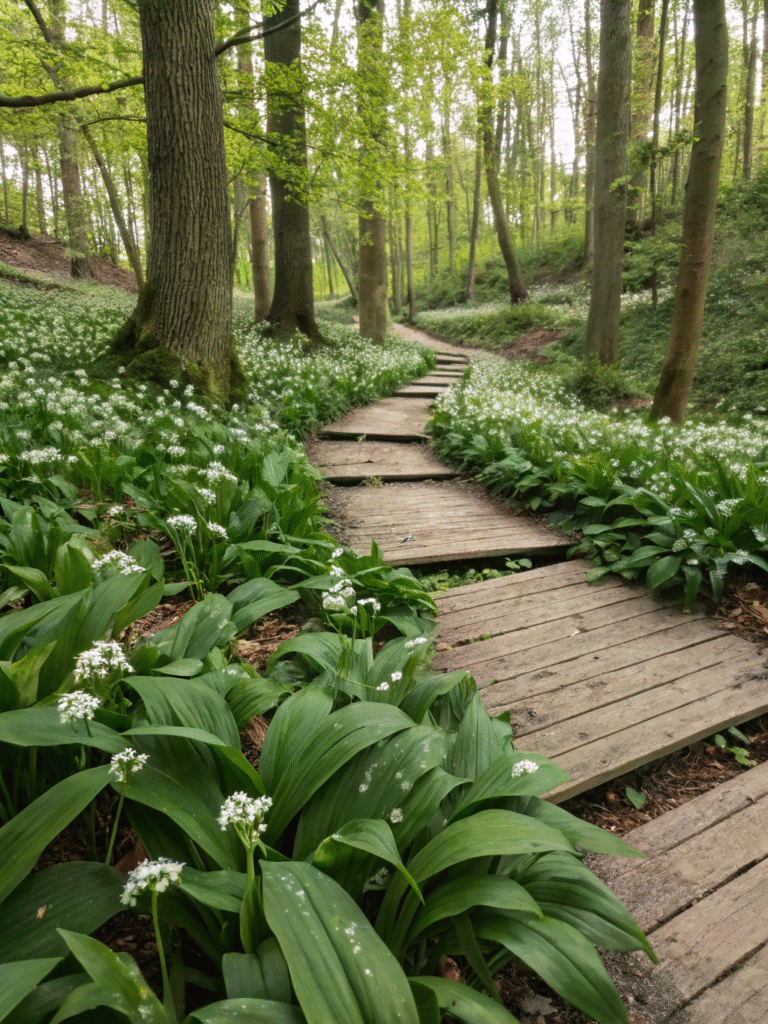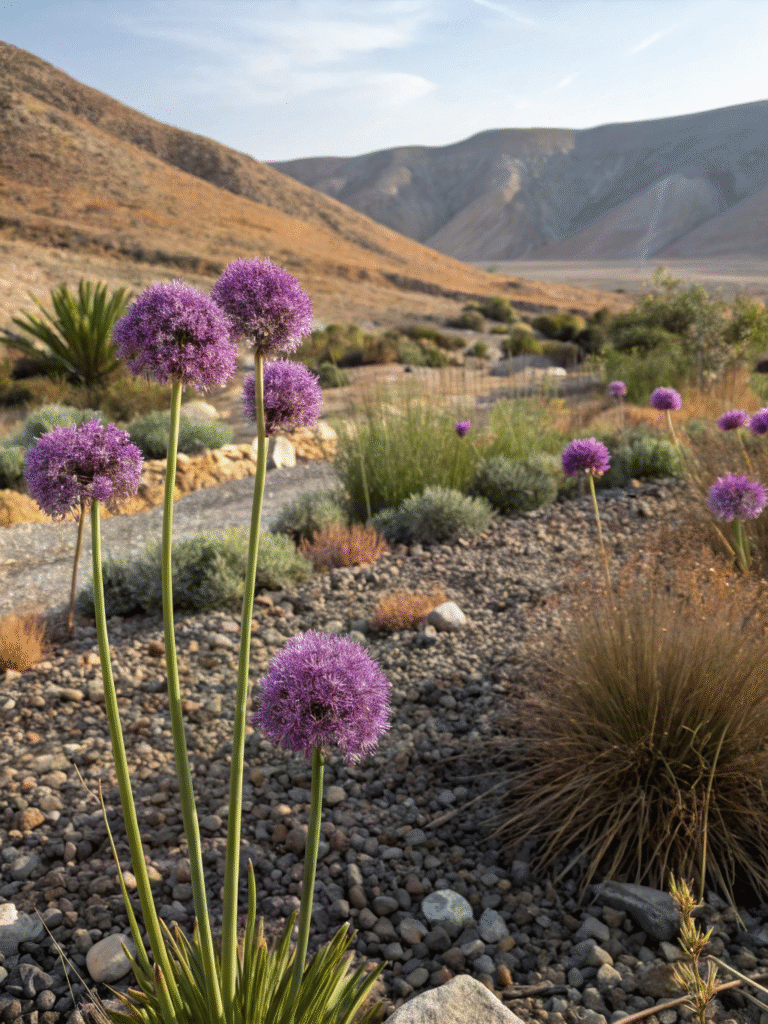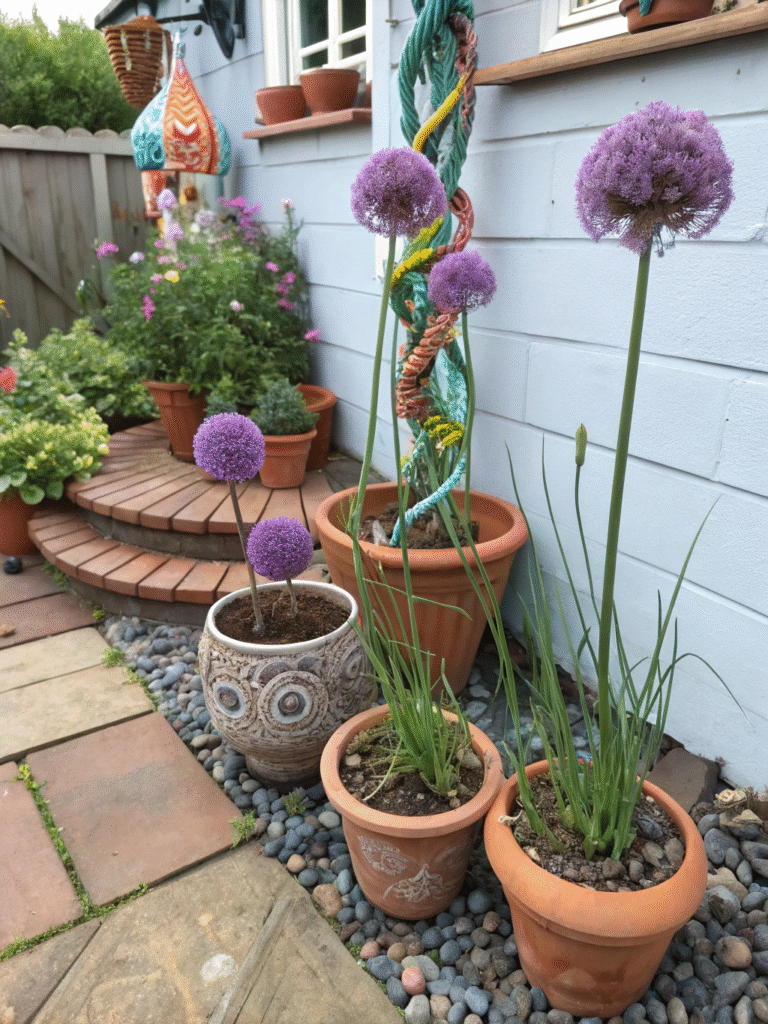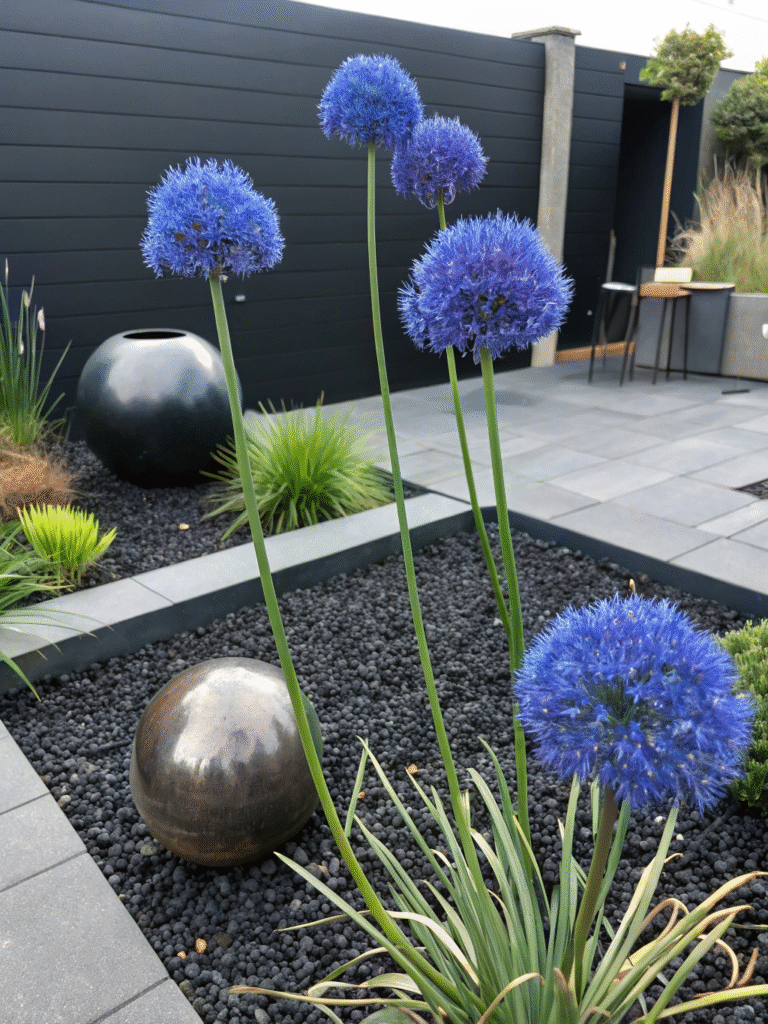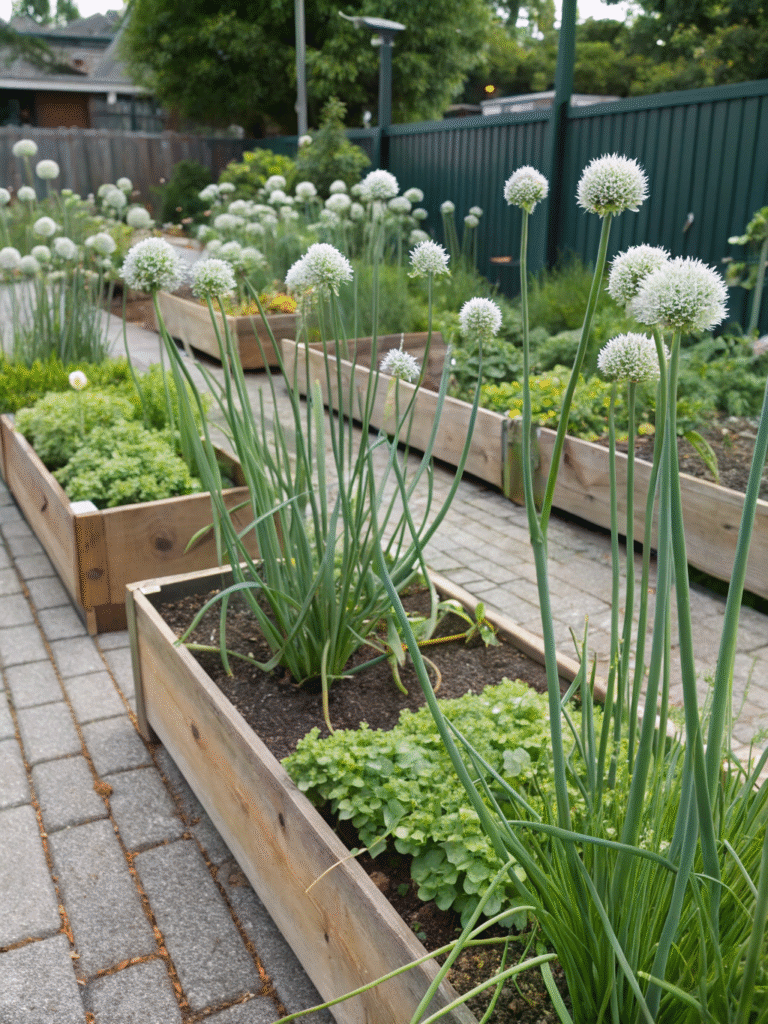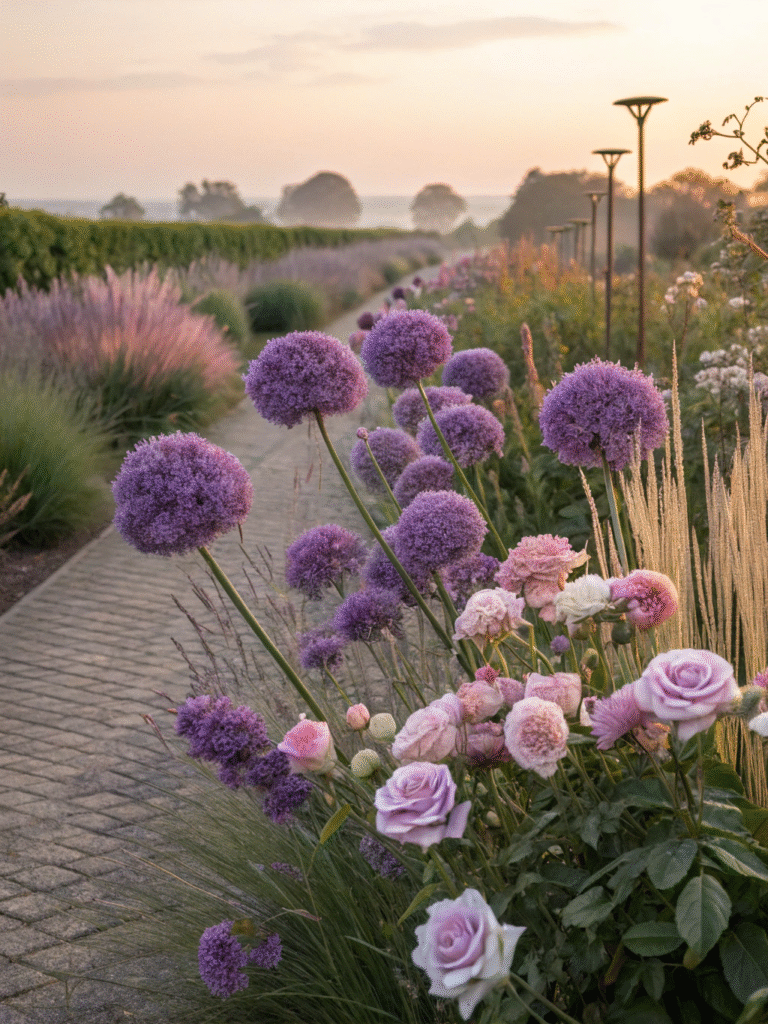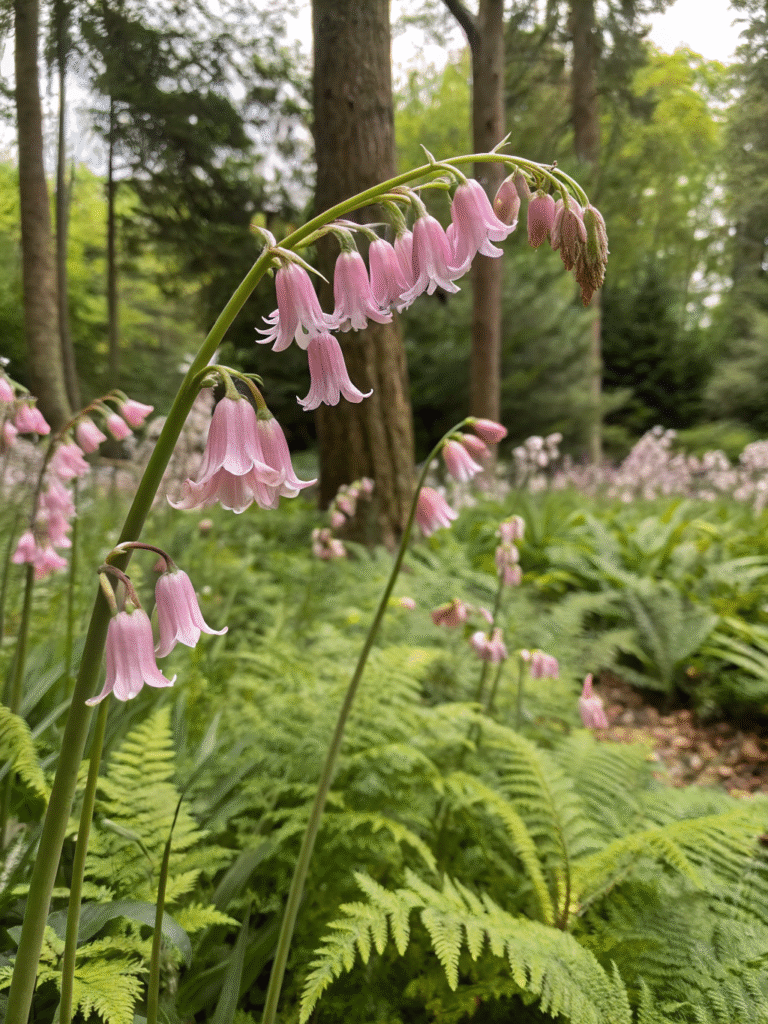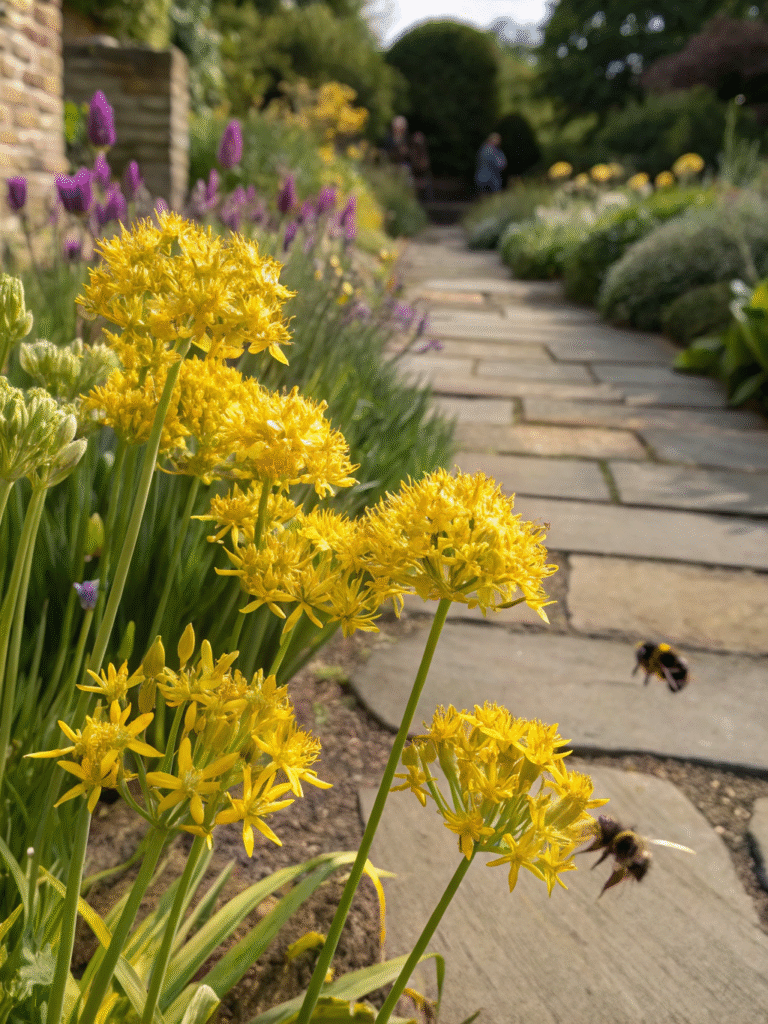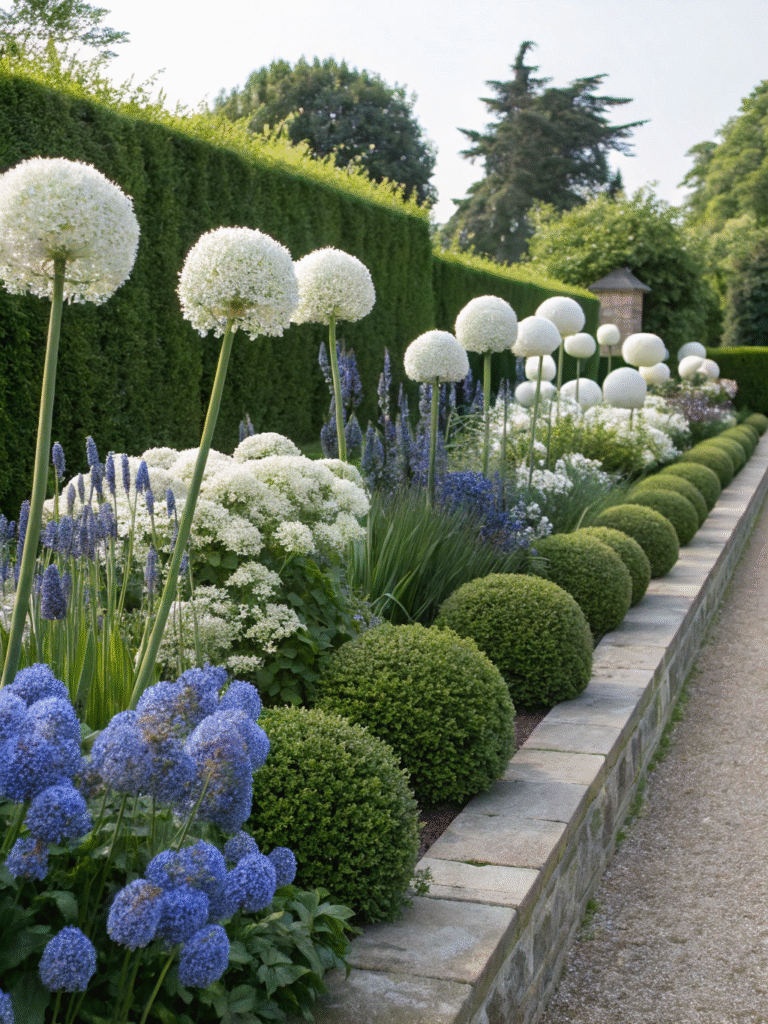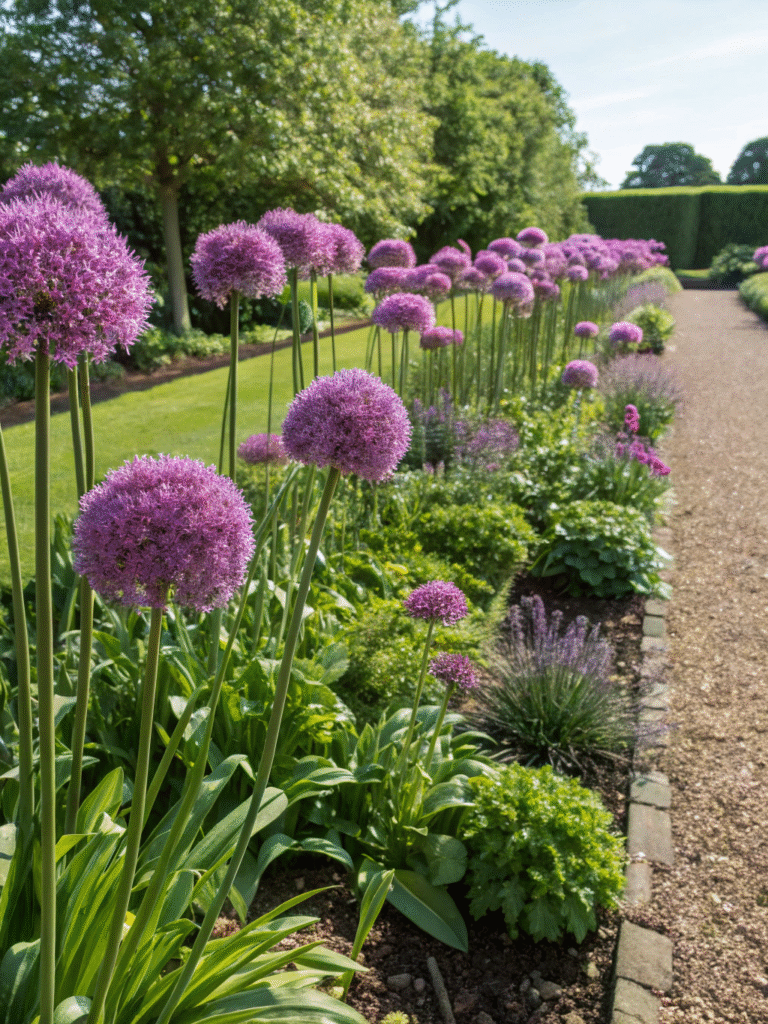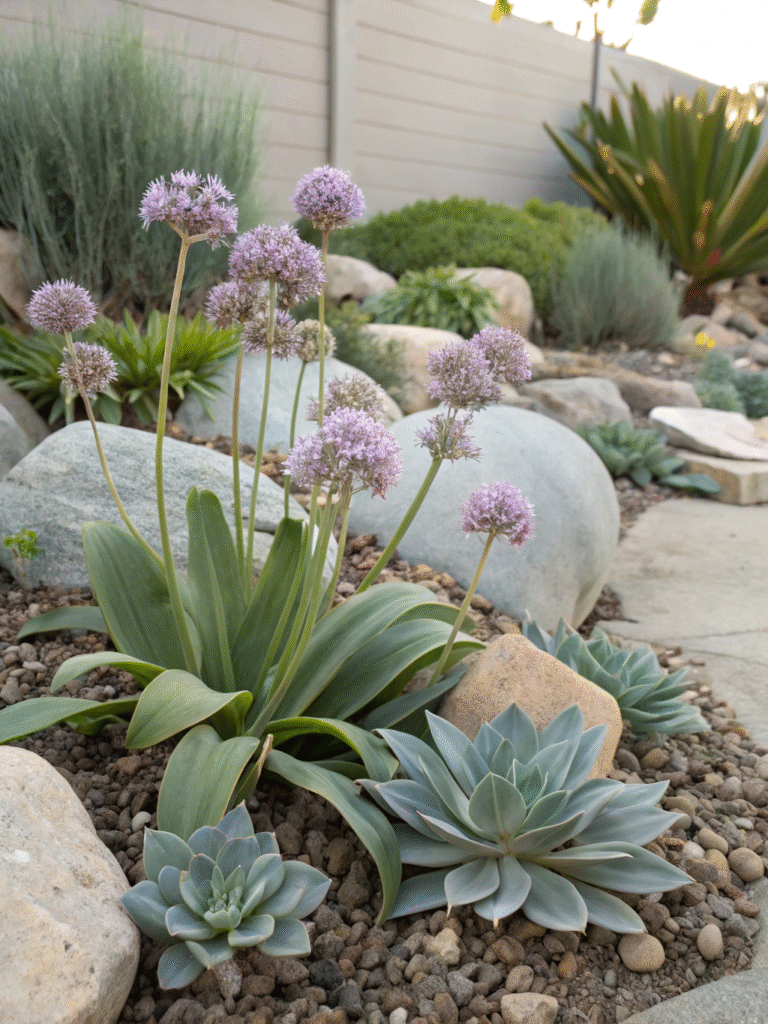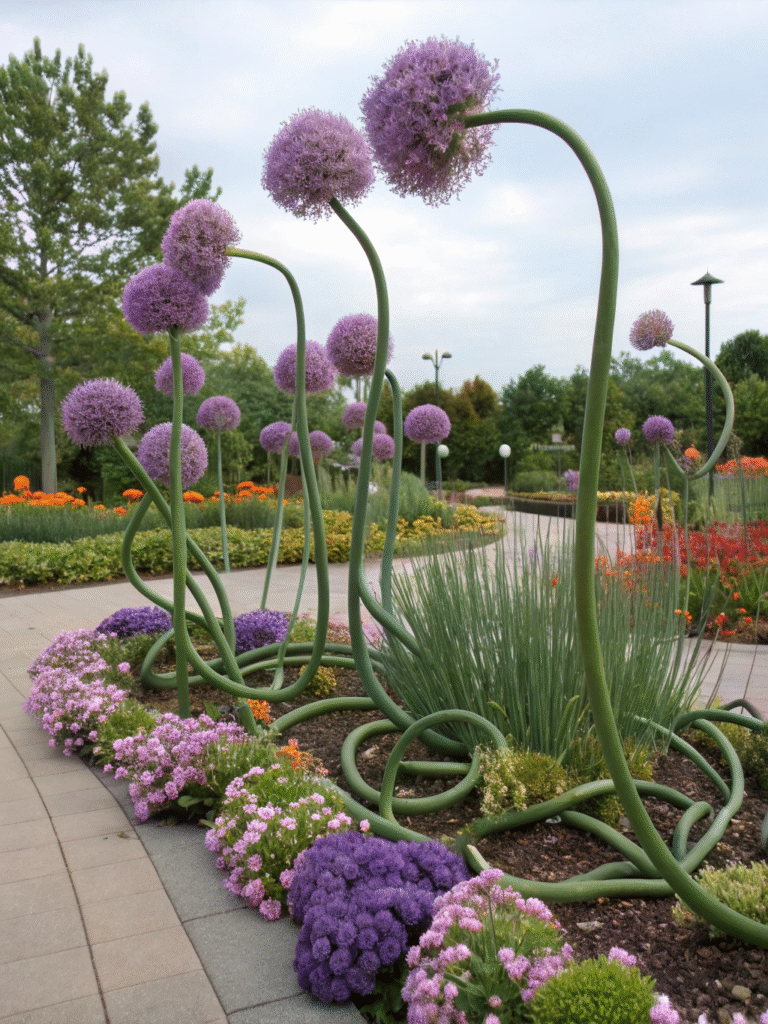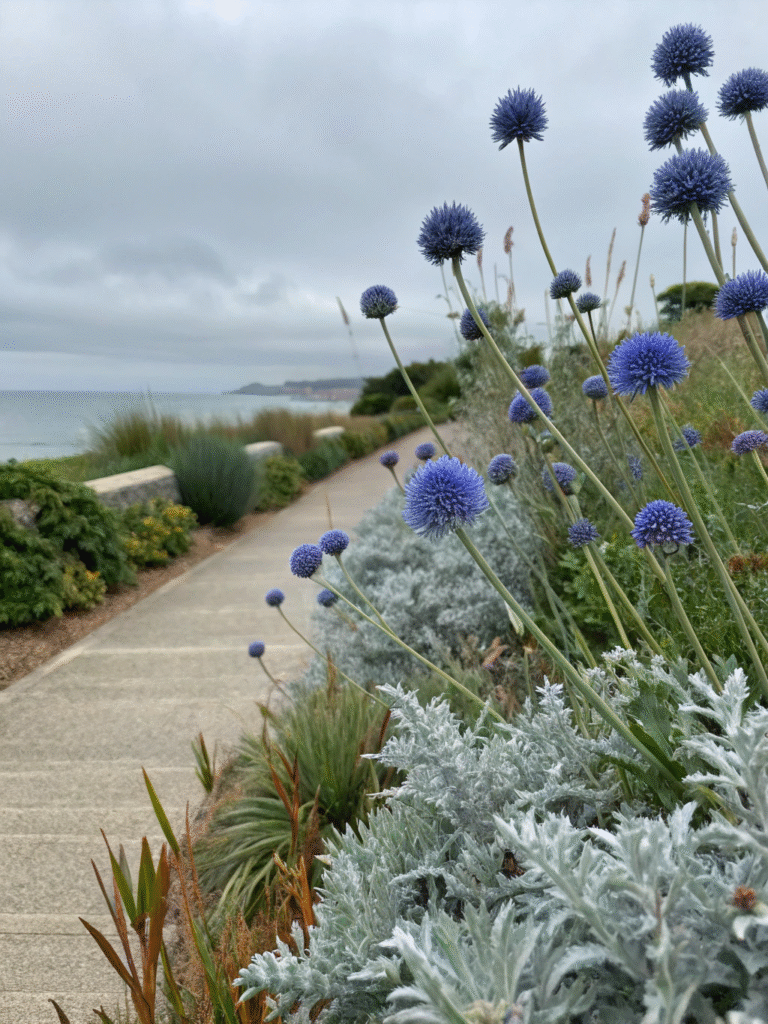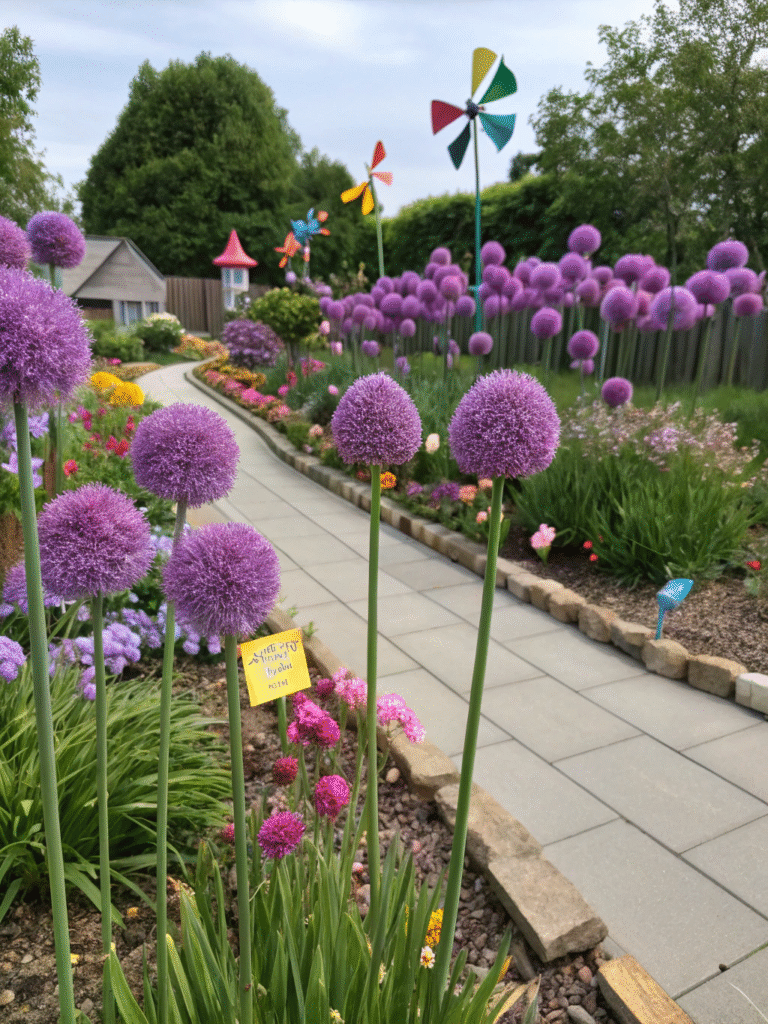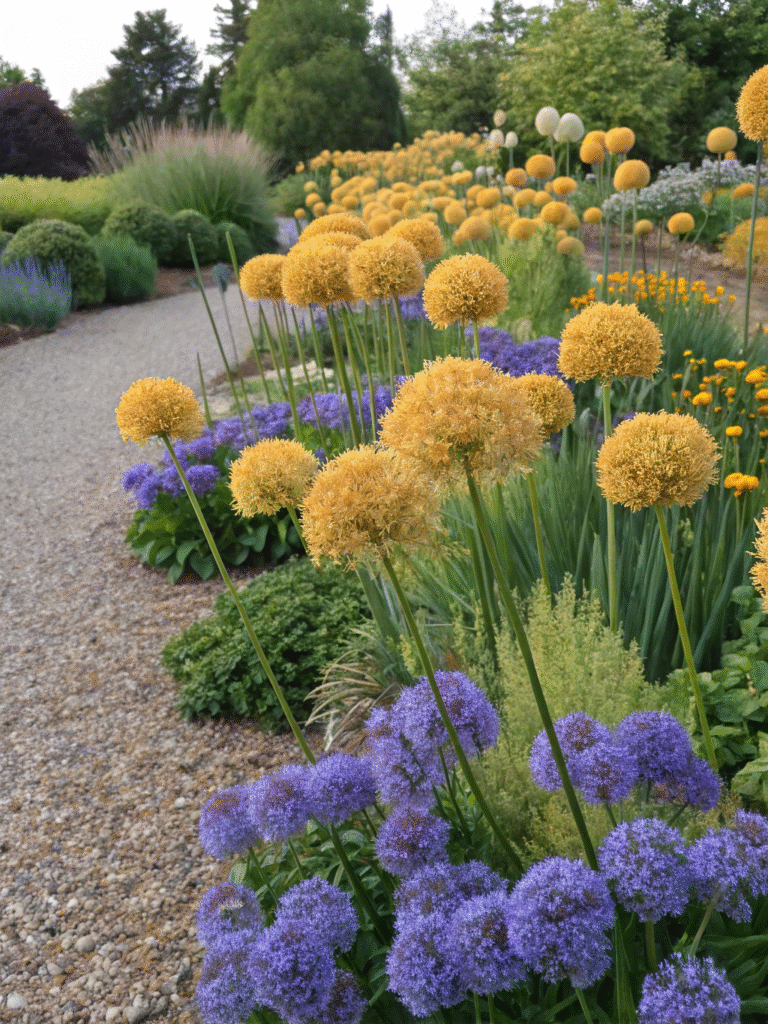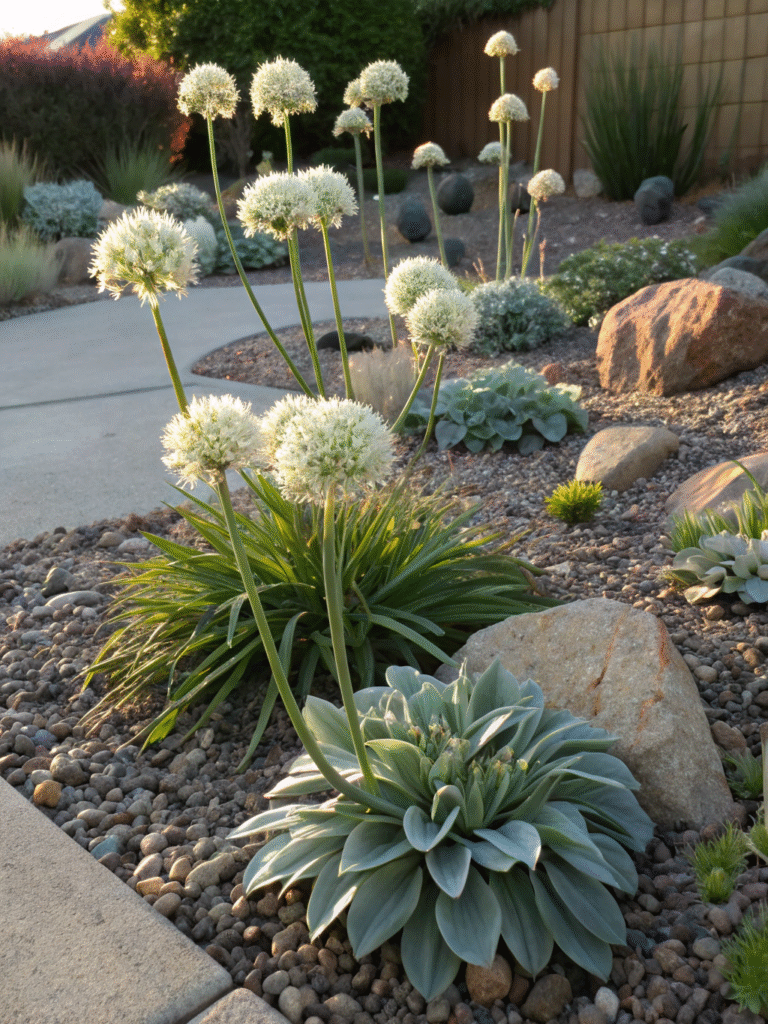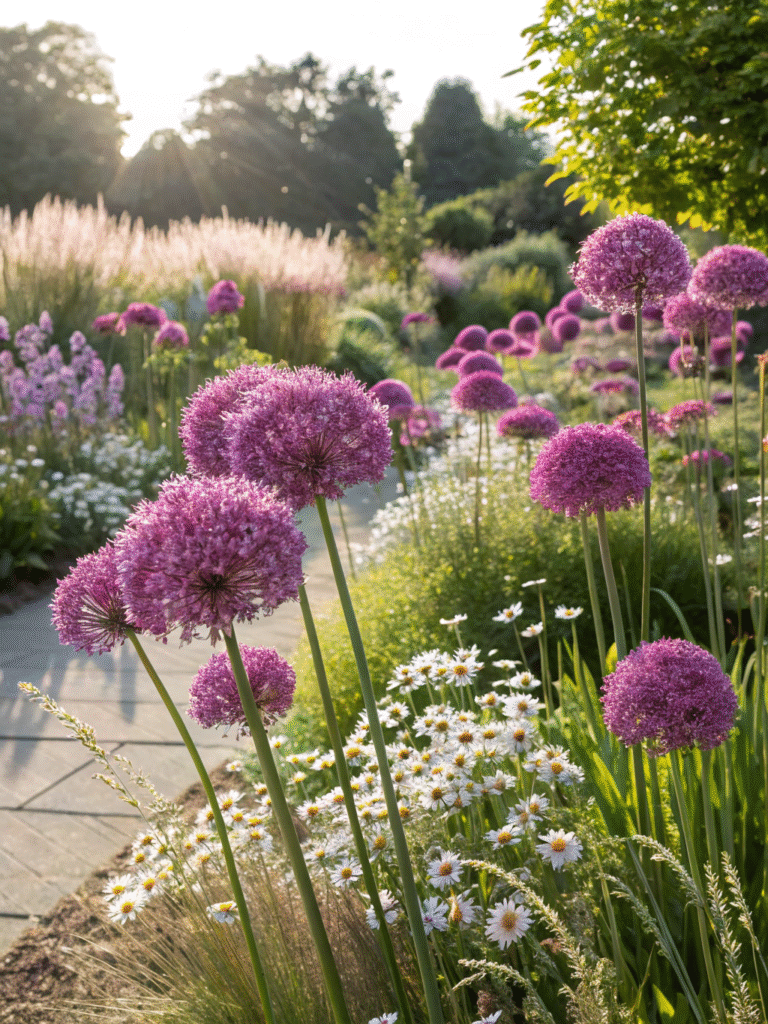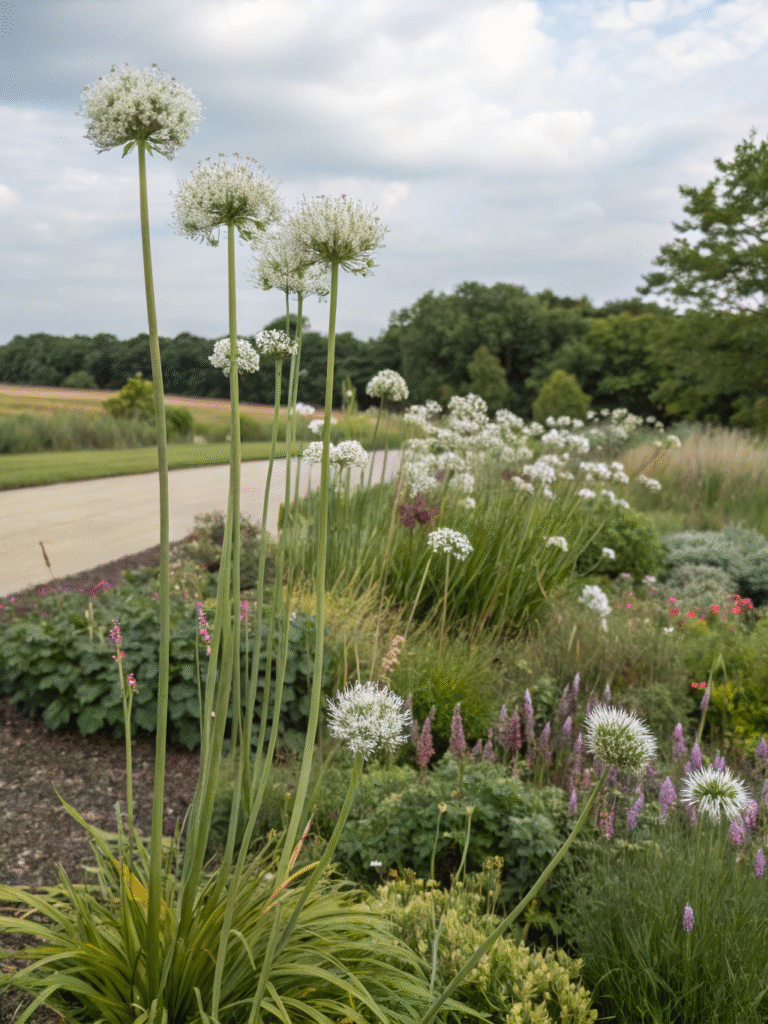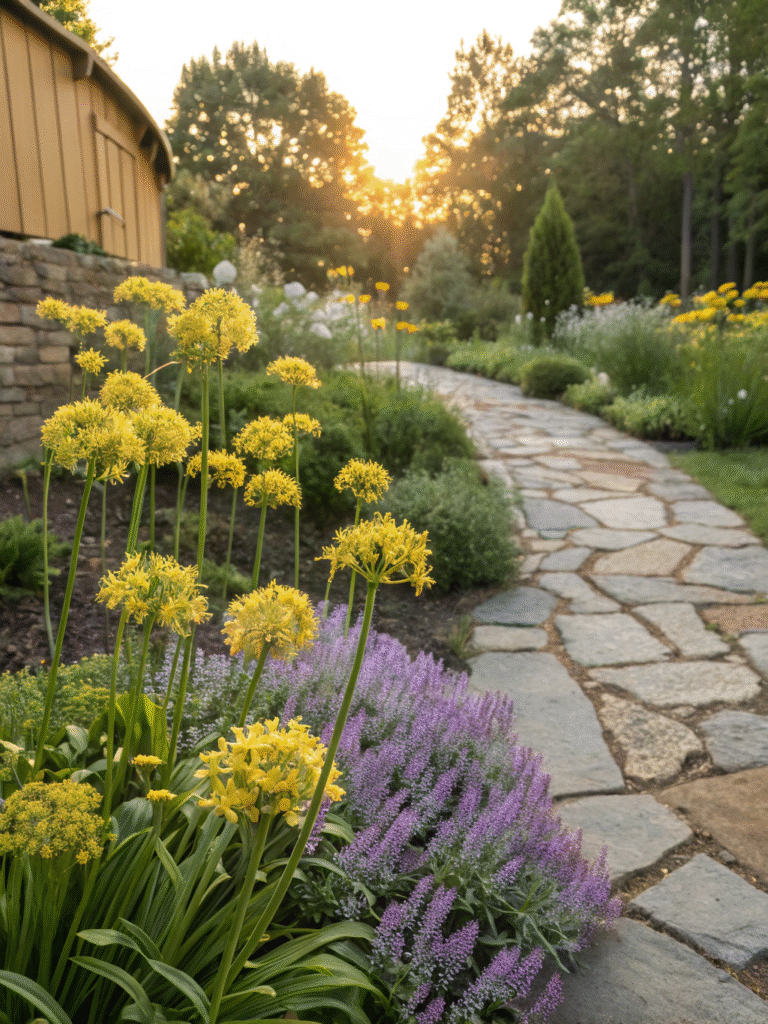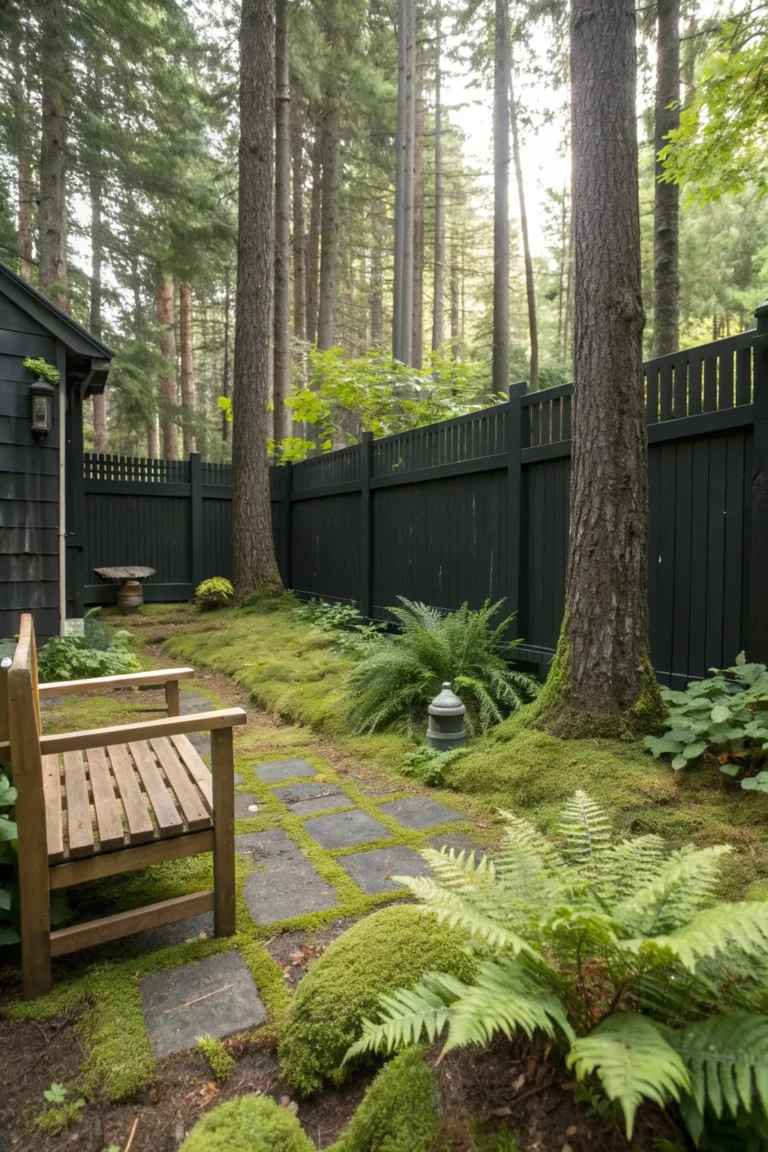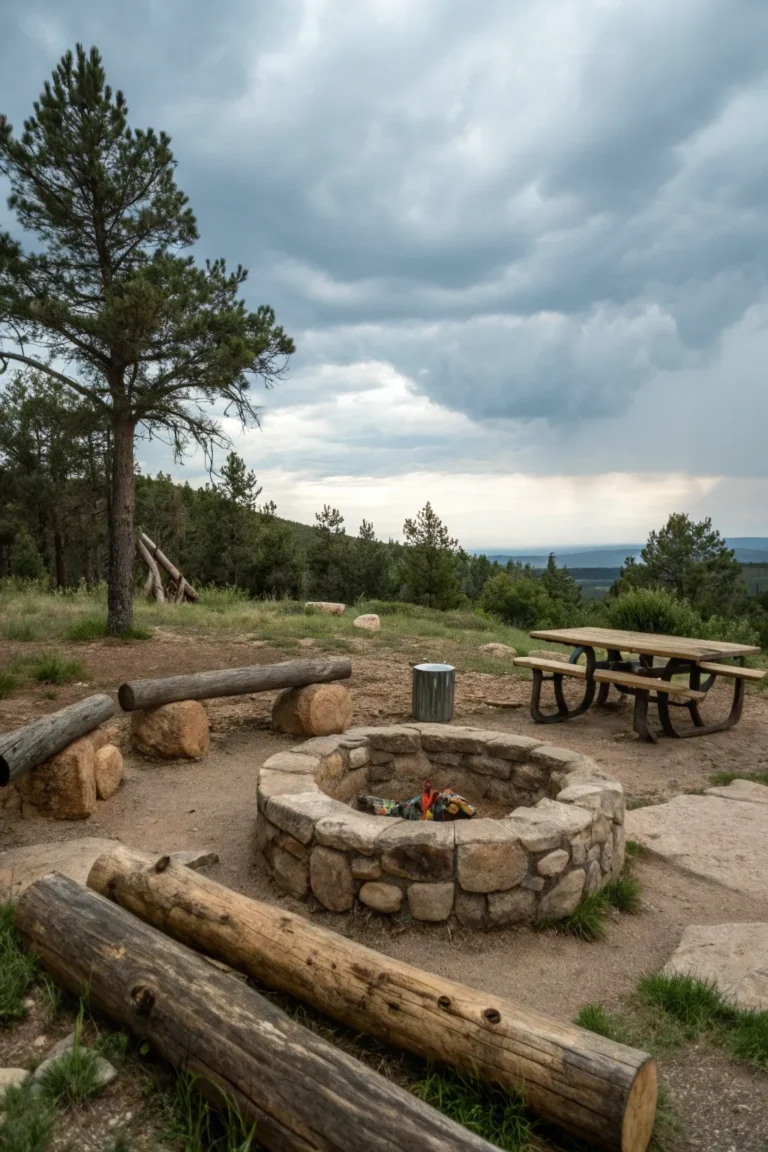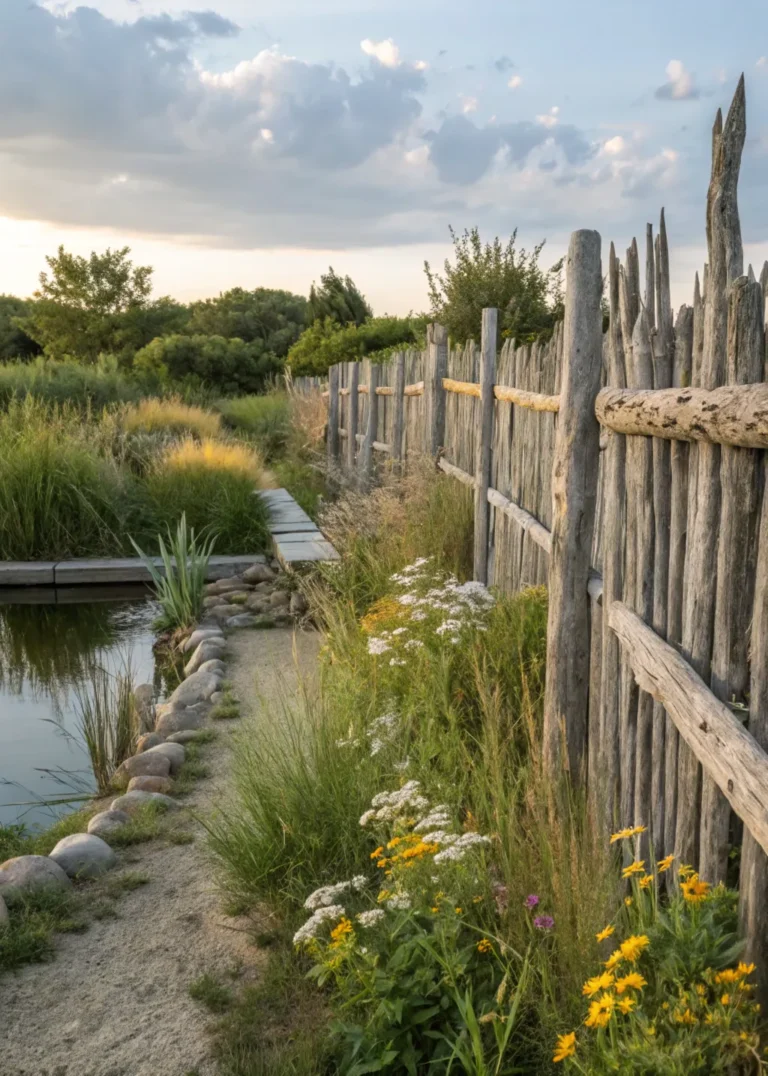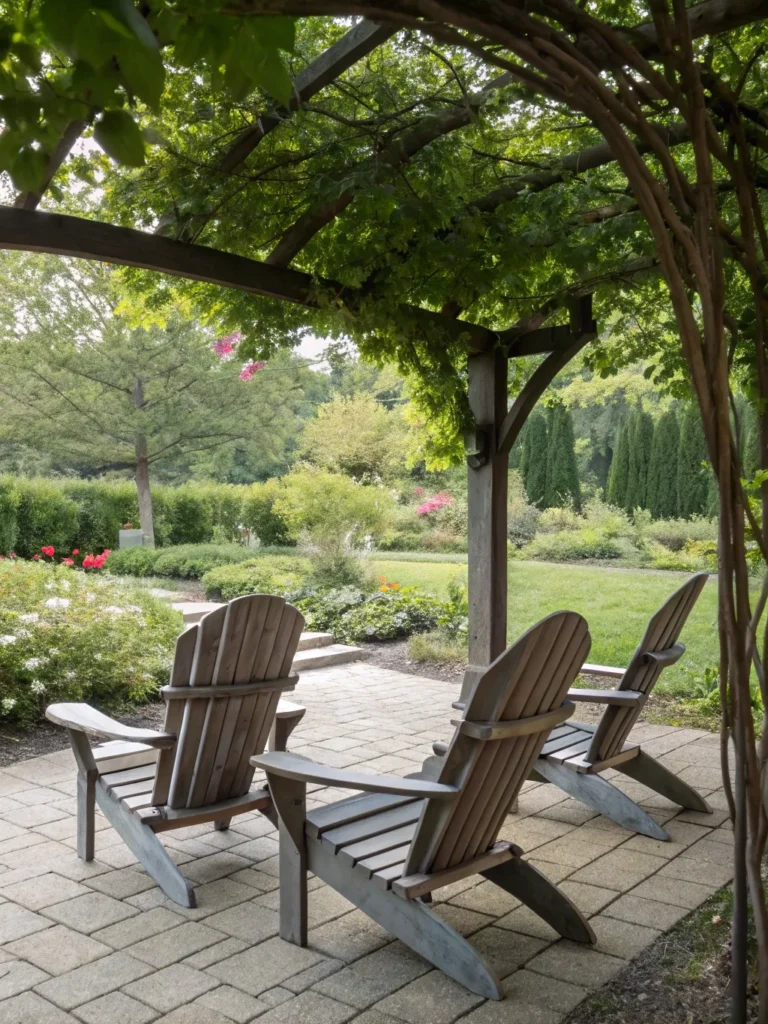Gardens With Alliums: 51 Varieties to Transform Your Flower Beds
From bold purples to delicate whites, Gardens With Alliums are a feast for the senses. Whether you love whimsical blooms or architectural drama, these 51 types will elevate your landscape with effortless charm and low-maintenance beauty. Their unique shapes and vibrant hues add elegance, structure, and seasonal interest, making them a top choice for modern and classic gardens alike.
In this article, we'll cover
- Discover the Best Gardens With Alliums for Year-Round Color and Impact
- 1) Purple Sensation
- 2) Globemaster
- 3) Mount Everest
- 4) Christophii
- 5) Drumstick Allium
- 6) Schubertii
- 7) Gladiator
- 8) Ostara
- 9) Summer Beauty
- 10) Peacock’s Tail
- 11) Ivory Queen
- 12) Azure Allium
- 13) Hair Allium
- 14) Eros Allium
- 15) Allium Atropurpureum
- 16) Round and Glossy Allium
- 17) Yellow Allium Flavum
- 18) Cernuum Nodding Allium
- 19) Silver Spring Allium
- 20) Allium Sphaerocephalon
- 21) Snowcup Allium
- 22) Ivory Queen Allium
- 23) Allium Roseum
- 24) Neapolitanum Allium
- 25) Allium Tricoccum
- 26) Mongolian Allium
- 27) Curly Hair Allium
- 28) Neon Blue Allium
- 29) Fistulosum Scallion
- 30) Allium Unifolium
- 31) Purple Haze Allium
- 32) Pink Chimes Allium
- 33) Golden Garlic Allium
- 34) White Giant Allium
- 35) Millenium Allium
- 36) Allium Karataviense
- 37) Medusa Allium
- 38) Blue Drumstick Allium
- 39) Grape Bubblegum Allium
- 40) Gold Rush Allium
- 41) Karataviense Ivory Queen
- 42) Ostrovskianum Allium
- 43) Multibulbosum Allium
- 44) Moly Allium
- How to Design Stunning Gardens With Alliums
- When and Where to Plant Alliums for Maximum Impact
- Alliums for Every Garden Style
- Final Thoughts
- Frequently Asked Questions
- What is the best time to plant allium bulbs?
- Do alliums come back every year?
- Are alliums deer-resistant?
- Can I grow alliums in containers?
- Do alliums attract pollinators?
Discover the Best Gardens With Alliums for Year-Round Color and Impact
1) Purple Sensation
Purple Sensation is a garden favorite, prized for its tall stems and vivid violet, globe-like flowers that bloom in late spring. These striking blooms rise above most plants, adding height and drama to your landscape. Their spherical shape brings geometric charm to both classic and modern gardens.
Plant them in clusters along borders or walkways for maximum impact. They pair beautifully with ornamental grasses, white perennials, or early summer flowers. As a bonus, they attract pollinators while resisting deer. Whether fresh or dried, these blooms bring long-lasting beauty to cutting gardens and floral arrangements.
2) Globemaster
Globemaster is renowned for its massive, globe-shaped flower heads that can span nearly 10 inches across. Blooming in early summer, these lavender-purple spheres perch on thick, sturdy stems that resist wind and add bold structure to the garden.
This variety looks stunning when planted in groups, especially in garden beds with peonies, ornamental grasses, or hostas. Its dramatic size makes it a favorite near patios or beside garden seating for maximum visual impact. Long-lasting and deer-resistant, Globemaster offers beauty and durability all in one.
3) Mount Everest
Mount Everest stands out with its pristine, white globe-shaped flowers atop strong stems that reach up to 3 feet tall. Blooming in late spring to early summer, this variety adds elegance and light to any planting scheme.
Use Mount Everest to brighten shaded corners or provide contrast against darker flowers like Purple Sensation. Its clean appearance makes it a perfect addition to formal gardens or moonlit spaces. Plant it in well-drained soil with full sun for best results.
4) Christophii
Christophii, or Star of Persia, is one of the most sculptural alliums available. Its large, airy flower heads form metallic lavender starbursts that shimmer in sunlight and add texture to garden beds.
This late-spring bloomer is especially valued for its decorative seed heads, which remain attractive long after flowering. Use it in contemporary garden designs or naturalistic plantings for year-round visual interest. It thrives in full sun and dry, well-drained soils.
5) Drumstick Allium
Drumstick Allium (Allium sphaerocephalon) brings playful charm with its egg-shaped blooms that shift from green to deep purple as they mature. Flowering in mid-to-late summer, it extends the blooming season beautifully.
These slender-stemmed plants sway gently in the breeze, adding movement and softness to garden borders. They pair well with ornamental grasses and look especially striking in mass plantings. Low maintenance and pollinator-friendly, they’re a smart choice for casual and cottage-style gardens.
6) Schubertii
Schubertii is the fireworks of the allium world, producing starburst-shaped blooms that shoot outward like an explosion. The flower heads can reach up to 12 inches across, appearing as if suspended in mid-air.
This variety blooms in late spring and is perfect for adding architectural drama to contemporary garden designs. Even after flowering, its seed heads remain decorative and sculptural, ideal for drying or use in winter displays. Plant in full sun with well-drained soil for best results.
7) Gladiator
Gladiator lives up to its name with strong stems that can reach over 4 feet tall, supporting large, violet-purple globe blooms. Flowering in early summer, it adds bold vertical structure to garden beds.
Best planted at the back of borders, Gladiator pairs beautifully with shrubs and tall grasses. Its majestic stature also complements garden features like summer houses or fire pits. It’s both deer-resistant and pollinator-friendly, making it as practical as it is eye-catching.
8) Ostara
Ostara offers dense, vibrant purple blooms on short stems, making it a great choice for compact spaces. It blooms earlier than many large alliums, providing spring color when most gardens are just waking up.
Ideal for pots, small beds, or edging paths, this low-growing allium fits well in urban and courtyard gardens. Its bold coloring ensures high impact without overwhelming the space.
9) Summer Beauty
True to its name, Summer Beauty offers glossy green foliage and lilac-pink blooms from midsummer through fall. Unlike many alliums, its leaves remain attractive throughout the season.
This clump-forming variety thrives in sun or partial shade and tolerates humidity better than most. It’s perfect for filling out garden borders or surrounding garden hammocks and seating areas. Long bloom time and pollinator appeal make it a garden workhorse.
10) Peacock’s Tail
Peacock’s Tail stands out with its wide, fan-shaped bloom structure and soft lavender-pink florets. Unlike spherical varieties, its blossoms spread horizontally, mimicking a bird’s display.
This unique form adds movement and elegance to flower beds. Perfect for exotic-style borders or rock gardens, Peacock’s Tail is a true statement piece. Plant in full sun with good drainage for best color and form.
11) Ivory Queen
Ivory Queen is a compact allium with striking silver-blue foliage and small white globe-shaped flowers that sit just above the leaves. Its tidy rosette form makes it ideal for front-of-border placement or rock gardens.
Flowering in late spring, it brings a refined elegance to smaller spaces. Even before blooming, the foliage adds interest with its broad, architectural leaves. It performs well in containers, gravel gardens, or as a low-maintenance accent in minimalist designs.
12) Azure Allium
Azure Allium delights with sky-blue, star-shaped flowers arranged in open clusters atop slender stems. Blooming in early summer, it adds a cool, calming hue to garden palettes dominated by warm tones.
This smaller allium looks especially attractive in Mediterranean or drought-tolerant landscapes. It thrives in dry soil and full sun and attracts bees and butterflies throughout its bloom period. Ideal for mixing with silver-leafed plants and ornamental grasses.
13) Hair Allium
Hair Allium stands out with wild, curly green filaments tipped in purple, forming one of the most whimsical blooms in the allium family. It blooms in late spring and instantly adds fun to any planting scheme.
Best used in naturalistic or informal gardens, Hair Allium is excellent for children’s gardens or quirky container arrangements. Despite its eccentric appearance, it’s hardy and easy to grow in full sun with well-drained soil.
14) Eros Allium
Eros Allium produces soft pink, bell-shaped flowers that cluster neatly on sturdy stems. It brings a romantic, airy feel to gardens, especially in early to mid-summer.
Its upright foliage and graceful blooms make it an excellent choice for cottage gardens, flower beds, and containers. Eros pairs well with soft-hued companions like lamb’s ear, nepeta, or pastel roses.
15) Allium Atropurpureum
Allium Atropurpureum offers rich, dark purple flowers that verge on black, lending dramatic contrast to your garden. These dense, domed heads bloom in early summer and rise on stems up to 30 inches tall.
Ideal for adding depth and boldness, they look stunning next to pale blooms like Mount Everest or bright yellows like Moly. This variety is a favorite for modern, moody, or gothic-style gardens.
16) Round and Glossy Allium
Round and Glossy Allium lives up to its name with polished, perfectly spherical flower heads in a deep violet shade. These blooms appear highly symmetrical, offering a refined look that fits beautifully in contemporary or formal gardens.
Its sturdy stems and tidy form make it ideal for creating repetition and order in garden beds or along walkways. Plant it in groups for best visual impact, especially when paired with white gravel, low boxwood hedges, or minimalist hardscaping.
17) Yellow Allium Flavum
Allium Flavum brings a cheerful burst of color with its drooping, bell-shaped yellow flowers. These blooms appear in midsummer and provide a sunny contrast to cooler tones in your planting scheme.
This variety thrives in dry, rocky soils, making it a top pick for xeriscaping or alpine gardens. Its compact size and drought tolerance make it especially useful in low-maintenance spaces. Combine with lavender or blue salvia for a beautiful, contrasting display.
18) Cernuum Nodding Allium
Native to North America, Cernuum Nodding Allium produces delicate, nodding pink blooms that sway gracefully in the breeze. Its arching stems and bell-shaped flowers add motion and softness to garden borders.
Perfect for naturalistic and prairie-style gardens, it also supports local pollinators. This allium thrives in full sun and well-drained soil. Plant in clusters for a charming, meadow-like effect.
19) Silver Spring Allium
Silver Spring Allium dazzles with its crisp white petals and deep purple centers. The bicolor contrast gives each bloom a refined and artistic appearance that draws attention in any setting.
It blooms in late spring and reaches around 2 feet in height. Use Silver Spring to enhance moon gardens or white-themed planting schemes. Its unique color pattern makes it a wonderful choice for borders, paths, and even cutting gardens.
20) Allium Sphaerocephalon
Also known as the Drumstick Allium, Sphaerocephalon features tight, oval-shaped flower heads that shift from green to burgundy. It blooms in mid-to-late summer, adding vertical texture during the gap between spring and autumn flowers.
This versatile allium blends seamlessly with grasses and perennials. It’s often planted en masse for a rhythmic, swaying effect in the wind. Great for wildflower gardens, modern landscapes, or natural borders.
21) Snowcup Allium
Snowcup Allium is a charming, low-growing variety that produces clusters of crisp white blooms. These blossoms emerge on short stems, making them ideal for front-of-border plantings or as edging along pathways.
Their subtle appearance brings calm and balance to gardens filled with more vibrant alliums. Snowcup also thrives in alpine or rock gardens where space is limited. Combine it with colorful companions like Azure Allium or Drumstick for a beautiful contrast.
Ideal for front-of-border plantings or alpine gardens. Its subtle look complements bolder blooms.
22) Ivory Queen Allium
Ivory Queen Allium stands out for its bold silver-blue foliage and creamy white flower heads. It forms a neat, symmetrical rosette, with blooms rising just above the leaves in late spring.
This repeat mention highlights its value in compact and container gardens. Ivory Queen thrives in full sun and well-drained soil, adding light and texture to rockeries, borders, or minimalist plantings.
Great for sunny rockeries or garden borders needing brightness and texture.
23) Allium Roseum
Allium Roseum produces soft, rose-pink blooms arranged in loose, umbrella-like clusters. These delicate flowers bloom in early summer, adding a gentle romantic touch to garden beds.
It naturalizes easily, making it a great pick for cottage gardens or informal landscapes. Plant in full sun with well-drained soil, and pair with airy companions like geraniums or cosmos for a dreamy effect.
It blooms in early summer and thrives in full sun. Pair it with geraniums or sedums.
24) Neapolitanum Allium
Also known as Naples Garlic, Neapolitanum Allium showcases white, star-shaped flowers in umbrella-like clusters. It blooms in mid-spring, offering early-season interest.
Ideal for naturalizing in wildflower meadows, woodland edges, or informal beds. Its graceful stems and fragrant blooms attract pollinators while adding lightness to the landscape.
It naturalizes easily and is excellent for wildflower-style plantings.
25) Allium Tricoccum
Commonly known as ramps or wild leeks, Allium Tricoccum is prized both for its culinary and ornamental value. Broad green leaves appear in early spring, followed by small white flowers.
Best suited for shady, woodland gardens, this native allium spreads gently to form lush ground cover. It’s a great choice for natural gardens and edible landscapes alike.
Its broad green leaves and white flowers make it a favorite for shady woodland gardens.
26) Mongolian Allium
Mongolian Allium showcases dense, round flower heads in a rich purple hue, standing tall on strong, upright stems. These blooms appear in late spring to early summer and hold their shape well over time.
This variety thrives in challenging conditions, including rocky soil and dry climates, making it ideal for low-maintenance landscapes. It pairs well with ornamental grasses or drought-tolerant perennials. Use it in gravel gardens, raised beds, or mixed borders for a bold splash of color.
Ideal for tough growing conditions. This hardy variety handles extreme climates well.
27) Curly Hair Allium
Curly Hair Allium is named for its whimsical, twisted green leaves that curl in all directions. Its small, rounded purple flowers bloom atop wiry stems, creating an eye-catching display in late spring.
Perfect for adding texture and character, this variety thrives in containers, borders, or rock gardens. It’s a favorite among children and visitors for its playful form. Curly Hair Allium is easy to grow, requiring full sun and well-drained soil.
Use it in containers or borders needing texture. Kids and visitors love its quirky look.
28) Neon Blue Allium
Neon Blue Allium makes a statement with its electrifying, deep blue blooms that appear in late spring to early summer. These vibrant, compact flower heads stand on slender, upright stems.
Ideal for bold garden designs, it pairs beautifully with silver-leafed plants and minimalist landscaping. This variety thrives in full sun and prefers dry to medium-moisture, well-drained soil. A striking option for containers and modern outdoor spaces.
Best showcased in modern or monochrome gardens for a striking contrast.
29) Fistulosum Scallion
Often grown for culinary use, Fistulosum (Welsh Onion) also brings visual appeal with its tall green stalks and small white pom-pom flowers. It blooms in late spring to early summer.
This multipurpose allium suits edible gardens, herb beds, or borders. Use it near patios or vegetable plots where its flavor and ornamental charm can both be enjoyed. It thrives in full sun and fertile, well-drained soil.
Perfect for edible landscapes or kitchen gardens.
30) Allium Unifolium
Allium Unifolium is known for its airy clusters of soft pink flowers and its signature single, strap-like leaf. Blooming in late spring, it adds a gentle elegance to shady garden edges.
This species prefers moist, well-drained soil and partial shade, making it perfect for woodland settings or underplanting beneath shrubs. It naturalizes well and offers subtle charm in groupings.
Excellent for moist, well-drained areas. Its understated beauty fits well in woodland edges.
31) Purple Haze Allium
Purple Haze Allium produces dreamy, smoky lavender blooms that appear in late spring. The rounded heads are slightly looser than classic varieties, giving the flower a soft, flowing look.
It blends beautifully with ornamental grasses and pale-colored companions like soft pink roses or nepeta. Ideal for cottage-style gardens or borders where a touch of mystery is welcome. Thrives in full sun with well-drained soil.
It pairs well with ornamental grasses and soft pink flowers.
32) Pink Chimes Allium
Pink Chimes Allium features delicate, bell-shaped blooms that dangle from arching stems in a soft, rosy hue. Blooming in mid-to-late spring, it adds an airy texture to your planting design.
Best suited for shady corners or beneath trees, this variety pairs well with ferns, hostas, or bleeding hearts. It thrives in partial shade and moist, well-drained soil. A lovely choice for romantic or woodland gardens.
This gentle allium is great for shady corners or romantic settings.
33) Golden Garlic Allium
Golden Garlic Allium (Allium moly) bursts with clusters of bright yellow, star-shaped flowers in early summer. These cheerful blooms are long-lasting and create a golden glow in garden beds or borders.
A reliable and low-maintenance variety, it’s deer-resistant and attracts pollinators. Plant in full sun or partial shade alongside blues and purples for a striking contrast. Excellent for rock gardens, cottage gardens, or edging paths.
Adds warmth to rock gardens or paths. Pollinator-friendly and drought-resistant.
34) White Giant Allium
White Giant Allium towers over the garden with 4–5 foot tall stems topped by massive, snowy white flower globes. These blooms appear in early summer and bring elegance and scale to any landscape.
Use as a focal point or plant in back borders for architectural drama. Pairs beautifully with cool-color perennials and ornamental grasses. Best in full sun and well-drained soil.
Use it as a garden focal point or in architectural plantings.
35) Millenium Allium
Millenium Allium is a compact, clump-forming hybrid known for its bright rosy-purple, globe-shaped flowers. It blooms in mid-to-late summer and has attractive, glossy green foliage that holds up through the season.
This variety is loved for its long flowering time, tidy growth, and pollinator appeal. Use in borders, containers, or mass plantings for vibrant color and neat form. It thrives in full sun and resists deer and rabbits.
Perfect for low borders, and long-blooming with tidy foliage.
36) Allium Karataviense
Allium Karataviense is a compact variety known for its broad, grey-green foliage and soft lilac-pink blooms. The flower heads emerge just above the foliage in late spring, creating a tidy and elegant look.
This allium is perfect for small gardens, rockeries, or container displays. Its low-growing form and unique leaf texture make it a great contrast to taller companions like Gladiator or Globemaster. Thrives in full sun and well-drained soil.
Its neat rosette form fits beautifully in containers or rockeries.
37) Medusa Allium
Medusa Allium lives up to its name with twisting, serpentine leaves that create visual movement and intrigue. The soft purple, spherical blooms rise above the foliage in early summer.
Great for adding texture to borders or mixing with low groundcovers, Medusa Allium thrives in full sun. It’s especially striking in whimsical or eclectic garden themes and works well in containers too.
Great for mixing with groundcovers or other eccentric textures.
38) Blue Drumstick Allium
Blue Drumstick Allium offers cool-toned, icy blue flower heads atop slender green stems. Blooming in early to mid-summer, these small blooms provide a soft color accent in cooler garden palettes.
They’re perfect for coastal or seaside landscapes and mix beautifully with silver or white companion plants. Compact and pollinator-friendly, this variety performs best in sunny, well-drained spots.
Perfect for cooler palettes or seaside gardens.
39) Grape Bubblegum Allium
Grape Bubblegum Allium features rounded, candy-colored purple flower heads that bloom in late spring. The name reflects its playful, bold aesthetic that appeals to kids and garden visitors alike.
This variety is great for adding cheerful pops of color along borders or walkways. It thrives in full sun and attracts pollinators while resisting deer. A fun choice for family-friendly gardens.
It makes an excellent border plant and is loved by kids and pollinators alike.
40) Gold Rush Allium
Gold Rush Allium brings golden yellow blooms to your garden just as spring transitions into summer. These medium-sized flower heads add warmth and a sunny glow to any landscape.
Use it to brighten up rock gardens, mixed borders, or pathways. It pairs well with purple-flowering alliums like Atropurpureum or Purple Sensation. Hardy and easy to grow in most sunny locations.
Ideal for combining with purples or blues for contrast.
41) Karataviense Ivory Queen
Karataviense Ivory Queen is a compact and refined cultivar of the Karataviense species, offering creamy-white blooms atop broad, silvery foliage. Its flower heads are globe-shaped and rise just above the leaf rosette, creating a clean and elegant profile.
Ideal for small gardens, containers, or rockeries, this variety adds subtle brightness and structure to any space. It thrives in full sun and well-drained soil, and its tidy growth makes it easy to maintain. A great option for minimalist or urban gardens.
Its compact habit is perfect for small spaces.
42) Ostrovskianum Allium
Ostrovskianum Allium features vibrant magenta-pink blooms that appear in dense, rounded clusters. The medium-height stems and compact habit make it perfect for middle-border placements.
Blooming in late spring, it complements both bold and soft-toned companions. This variety is ideal for adding a splash of rich color to sunny borders, cottage gardens, or mixed perennial beds.
This vibrant species excels in sunny borders and mixed perennial beds.
43) Multibulbosum Allium
Multibulbosum Allium grows in dense clumps, producing clusters of star-shaped white flowers on tall, slender stems. Its name reflects its tendency to form multiple bulbs, which makes it excellent for naturalizing.
Ideal for covering ground in borders or filling in spaces between taller plants, it adds a light and airy feel. It’s particularly effective when planted en masse or alongside ornamental grasses.
Produces many white flowers, ideal for groundcover use.
44) Moly Allium
Moly Allium, also known as golden garlic, produces vibrant yellow flowers in late spring to early summer. Its cheery blooms are star-shaped and grow in clusters, bringing warmth and brilliance to garden borders.
This variety is hardy, deer-resistant, and thrives in a range of soil types. It’s a fantastic choice for beginner gardeners or anyone looking to add a sunny accent to cottage or herb gardens.
Deer-resistant and easy to grow, it’s perfect for beginners.
How to Design Stunning Gardens With Alliums
Designing a garden with alliums is both an art and a science. Their unique shapes, heights, and bloom times make them incredibly versatile. To maximize their visual appeal and seasonal impact, try the following layout strategies:
- Plant in odd-numbered groups (3, 5, or 7) to create natural-looking clusters.
- Layer by height: Place tall varieties like Globemaster or Gladiator at the back, mid-sized ones like Christophii in the center, and compact types like Ostara or Karataviense in front.
- Use repetition along pathways or borders for rhythm and flow.
- Contrast textures and colors by mixing alliums with grasses, peonies, or soft perennials.
- Let seed heads stand after bloom for extended architectural interest.
- Incorporate design elements like paths, edging, and garden water features to anchor your layout.
These techniques will help you create gardens that feel balanced, vibrant, and full of life across the seasons.
When and Where to Plant Alliums for Maximum Impact
To enjoy vibrant blooms from early spring to late summer, plant allium bulbs in the fall—ideally from September to November—before the ground freezes. Choose a sunny spot with well-drained soil to prevent rot and encourage strong growth.
For continuous color, select varieties with staggered bloom times. Early bloomers like Purple Sensation, mid-season stars like Globemaster, and late-summer charmers like Millenium or Summer Beauty can keep your garden lively for months.
Helpful tips:
- Avoid overly wet soil, especially in winter.
- Mix bulbs of different heights for a layered effect.
- Plant bulbs 2–3 times as deep as their height for stability.
To fully enjoy your allium display, place them near garden seating areas or pathways where you can admire them up close.
Alliums for Every Garden Style
No matter your design preference—cottage charm, sleek modernism, structured formality, or carefree wildness—there’s an allium that fits beautifully into your landscape.
- Cottage gardens benefit from softer blooms like Allium Roseum or Pink Chimes, which pair well with classic companions like geraniums and delphiniums.
- Modern gardens shine with architectural varieties such as Globemaster, Schubertii, or Round and Glossy for symmetry and bold structure.
- Formal gardens are enhanced with Ivory Queen or Mount Everest, offering clean lines and elegant coloring.
- Wild or naturalistic gardens can incorporate Drumstick, Hair Allium, or Cernuum for a flowing, meadow-like effect.
For extra charm, frame your planting around a Summer House or place near a Small Fire Pit to create a cozy, immersive garden experience.
Final Thoughts
Gardens with alliums aren’t just visually captivating—they’re practical, pollinator-friendly, and surprisingly easy to maintain. Their architectural shapes and wide color palette add depth and dimension to any garden style, from wild meadows to modern landscapes.
Alliums bloom in succession across spring and summer, keeping your garden alive with interest. They resist deer, thrive in tough conditions, and require minimal care once planted. With so many stunning options available, you can tailor a garden display that’s truly unique.
Plant a few today and you’ll see why alliums are celebrated by designers and home gardeners alike—they make any space bloom with bold beauty.
Frequently Asked Questions
What is the best time to plant allium bulbs?
Plant allium bulbs in the fall—typically from September to November—before the ground freezes. This gives the bulbs time to establish roots for a strong spring bloom.
Do alliums come back every year?
Yes, most alliums are perennials and return each year with proper care. Choose a sunny, well-drained site and avoid overwatering during dormancy.
Are alliums deer-resistant?
Absolutely. Alliums are known for their deer- and rodent-resistant properties due to their onion-like scent and taste.
Can I grow alliums in containers?
Yes! Compact varieties like Ivory Queen or Ostara are perfect for containers. Ensure your pots have good drainage and place them in full sun.
Do alliums attract pollinators?
Yes, alliums are excellent pollinator plants. Their nectar-rich blooms attract bees, butterflies, and other beneficial insects throughout the growing season.
Discover more from Leafy Haven Home | Stylish Garden Ideas & Cozy Decor Tips
Subscribe to get the latest posts sent to your email.

